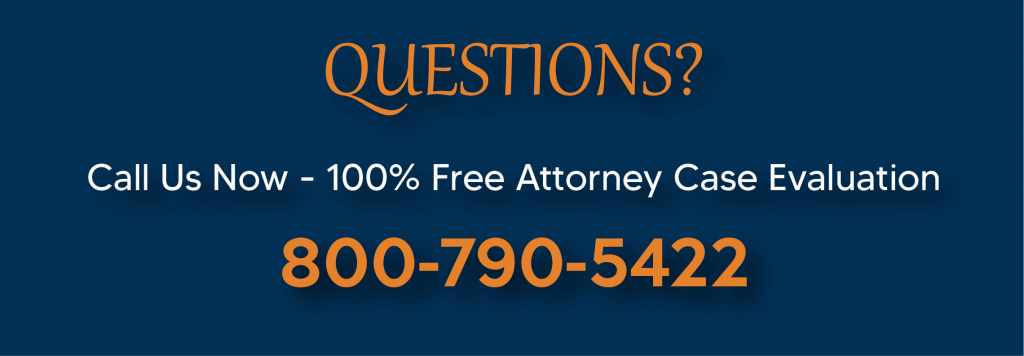UBER ACCIDENTS
The Ultimate Guide to Uber Accidents
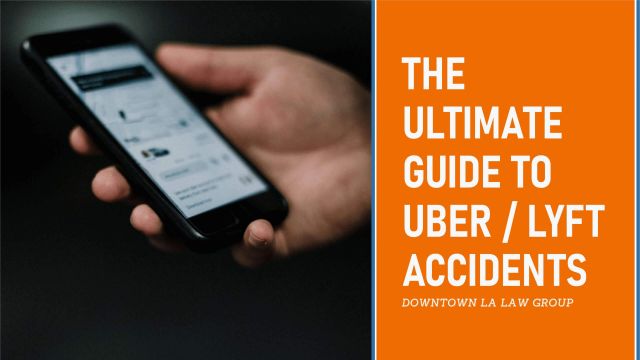
From The Nations No.1 Rated and Most Experienced Uber/Lyft Accident Law Firm
History of Uber
How Uber Works
Costs of Uber
- Cancellation cost
- Wait time fee
- Booking fee
- Cleaning fee
- Lost and found item fee
- Tolls and highway prices
Types of Uber Rides
- Pool
- Uber X
- Uber XL
- Uber Select
- Uber Black
- Uber Lux
- Self Driving Cars
Causes of Uber Accidents
- Speeding
- Tailgating
- Running Led Lights
- Improper Merging
- Running Stop Signs
- Right of Way Violations
- Parking Lot Crashes
- Drunk Driving
- Tired Driving
- Using Phone While Driving
- Vehicle Maintenance
- Weather
Common Injuries from Uber Accidents
- Bone Damage
- Muscle Injuries
- Brain Injuries
- Internal Injuries
- Neck and Spinal Cord Injuries
- Severed Limbs
- Permanent Injuries
- Paralysis
- Death

Real Clients – Real Results from the Countries Highest Rated Uber and Lyft Accident Lawyers
List Of Steps To Take After An Uber Accident
Uber’s History with Drivers
Important Uber Cases
- 2013 Vehicular Manslaughter of 6-year-old Girl
- 2015 Ruling for Driver Reimbursement
- Ongoing Class Action Lawsuit
- Incident with Blind Passengers and Service Dogs
Types of Uber Accidents
- Bikes
- Scooters
- Cars
- Pedestrian
- Assaults
Legal Rights Of Victims
- Uber Drivers
- Uber Passengers
- Third-parties
Uber’s Partner Insurance Policies and Information
- driver liability
- per accident
- property damage
- UberEATS
How Uber Is Liable In Accidents
How To File A Lawsuit Against Uber
Uber’s Settlements
- Gratuity/ Tip Case
- Background Checks
- Discrimination Lawsuit
- Embellishment Claim
- Sexual Assault Lawsuit
Statute of Limitations for Filing a Lawsuit against Uber
Determining the Value of Your Uber Lawsuit
- Your age
- Your job
- Your injuries
- Your level of negligence
- Coverage Of Medical Expenses
- Property Damage
- Missed Income from Your Job
- Pain and Suffering
- Punitive Damages
- Wrongful Death Expenses
Hiring an Attorney for Your Uber Accident
History of Uber
Common Questions
- How long has Uber been around? Uber was founded in 2009 and has been in operation since 2010.
- What are some of Uber’s competitors? Uber has various competitors for all of its services, including Lyft, Lime, Spin, Doordash, Postmates, Amazon Fresh, Sidecar, Turo, and others.
- Where does Uber operate? Uber has operations in 785 metropolitan areas, including New York, Los Angeles, San Francisco, Bangalore, Beijing, Taipei, London, Paris, and more.
Uber was initially funded as UberCab in 2009 as a way to provide luxury private drivers to individuals at a discounted price. Regular private drivers and limousines are quiFte expensive, but Uber’s initial price model only resulted in being a bit more expensive than regular taxicabs. Eventually, UberX was created after a rebrand left the company with just the name Uber; UberX allowed ordinary and non-luxury vehicles to transport customers. As rates were lowered, more options for customers began popping up. UberPOOL debuted four years after Uber hit the streets, eventually becoming its most popular service. In just two years after its foundation in San Francisco, Uber went live in New York City and Chicago. It would eventually reach other big cities but would face backlash in some and competition all around the world. For example, New York City is well known for its yellow taxi cab services and subway system. With the introduction of Uber, many taxi drivers and companies pushed back; there were claims of a lack of safety of the passengers, the company taking advantage of its workers, and of violating business practices and forcing workers to take less or lowered wages to compete. New York passed a law that forced Uber drivers to hold a commercial driving license, which takes a bit of time and training to acquire. As such, many Uber drivers were unable to pick up and transport customers with the same ease as they would in other parts of the country.
Complete a Free Case Evaluation form or call (855) 339-8879.
Uber’s international reach landed the company in the United Kingdom, Mexico, India, and China within a few years. As it began to grow more popular, it inspired other companies to create competition. Lyft is perhaps the most well known with Sidecar coming shortly after. It is not uncommon to see many drivers possess both the Lyft and Uber symbols in their windshields. Drivers may switch between the two apps depending on surge prices, available fares, preference, rating, and more.

How Uber Works
Common Questions
- What do I need to use Uber? You will need a smart phone like an Android or iPhone, a payment method as a passenger, and various required documents as a driver.
- Does Uber operate all night? Uber drivers work according to their own schedules, and may or may not be available throughout all hours of the night. It is to be expected that later hours will yield longer wait times, as fewer drivers will be available.
Uber works based on a GPS locating system that connects riders to nearby drivers. It shows a map of cars and the directions they are heading. Drivers can elect to accept certain rides or deny them. To use Uber, follow these steps: Download the app onto your smart phone via the Google Play store, App Store, or other location. Make sure you have ample space and that you allow the app to send you notifications. Input your information and payment details, such as your name, email address, credit card or PayPal information, and phone number. By providing your phone number, the driver will be able to call you if he has any questions or concerns, or to tell you that he has arrived if you are not outside. When you are ready to take a trip, input your destination. There will be a number of cars displayed, as well as an estimated time of arrival. You may also schedule a ride for a later time. Select what kind of ride you want, whether a Pool ride, UberX ride, Uber Select, and more. If you select a Pool, you will likely have to walk to a nearby pick up point. You will then need to confirm this point with the app. Upon getting picked up, you can enjoy your ride, rate your driver at the end, and leave a tip if you so choose. Uber’s rating system is integral to drivers. A low rating may result in the driver getting suspended or barred from using the app, while a high rating can eventually allow the driver to offer other types of rides for customers. The drivers must maintain these ratings to continue to provide higher-end trips. At the same time, drivers can rate customers based on their behavior and attitude, as well as if they caused any delays or if they were rude to other passengers. A low rating may cause other drivers to be more cautious while picking up such riders. Drivers for Uber must meet certain requirements to be eligible to give rides to customers. They must meet the minimum driving age in the city of choice, have one year of licensed driving experience in the US (or 3 years if the driver is under the age of 23), have a valid US driver’s license, and must possess an eligible 4-door vehicle. They must also have proof of residency in the city and state, proof of vehicle insurance, and a clean background check. The company tries to prioritize safety for both drivers and passengers. Drivers are thus given access to an emergency assistance button that allows drivers to quickly share their trip information and location with emergency services in the event of an incident; incident support with a representative at Uber; trip sharing that allows drivers’ friends and family to know where they are at all times, so as to prevent any potentially dangerous situations; GPS tracking to ensure that trips do not go off route or into unknown areas; and detail anonymity, such as masking phone numbers and only providing first names.
Our Most Recent Rideshare Accident Settlements
$1.15 Million
RIDESHARE ACCIDENT
$1 Million
RIDESHARE ACCIDENT
$1 Million
RIDESHARE ACCIDENT – BACK INJURY
$1 Million
RIDESHARE – INJURY TO PASSENGER
$1 Million
RIDESHARE ACCIDENT
$1 Million
RIDESHARE ACCIDENT
$1 Million
RIDESHARE ACCIDENT
$966,500
RIDESHARE ACCIDENT
$1 Million
RIDESHARE ACCIDENT
$1.15 Million
RIDESHARE ACCIDENT
$1 Million
RIDESHARE ACCIDENT
$1 Million
RIDESHARE ACCIDENT – BACK INJURY
$1 Million
RIDESHARE – INJURY TO PASSENGER
$1 Million
RIDESHARE ACCIDENT
$1 Million
RIDESHARE ACCIDENT
$1 Million
RIDESHARE ACCIDENT
$966,500
RIDESHARE ACCIDENT
$1 Million
RIDESHARE ACCIDENT
$2.375 Million
Rideshare Passenger Injury
Costs of Uber
Common Questions
- Do I have to tip on Uber rides? Tipping is optional, but if you do elect to tip, there is a selection you can make to input your number.
- How do I pay for Uber? Uber will take payments from PayPal, credit card, debit card, bank account, Google Pay, and more. It is meant to be a cashless experience in the majority of cities served.
A big reason that many people elect to hop in Ubers to get around is the relatively cheap costs when compared to other forms of transportation. Traditional taxi cab services and limousines are often very expensive, and the drivers are considered employees of the businesses who are paid hourly wages. They are able to receive tips, as well. However, the wait time for one of these cars may be too much for a rider. Because Uber pairs riders with nearby drivers, there is a very small wait time for ride request. Some short trips that total less than 20 minutes may wind up costing fewer than $5.00. For many customers, the convenience is one of the selling points. It is worth the extra dollar or two if they do not have to leave their house or if they do not have to wait very long for a car to leave an agency. Further, they do not have to wait too long for public transportation, which may have dozens of stops before their destinations are reached.
Uber Pool rides are by far the cheapest, given that rides are shared by other individuals going the same direction and you must walk to a nearby pick up location. The more luxurious options you select, the more expenses the ride will be. Surge pricing is a tactic that Uber uses to boost its fares dung times of slow moving traffic or when the destination or pick up point is in an extremely populated area. Surge pricing may result in fares ascending to as much as four times as much as they usually cost during this period. Surge prices are most commonly seen in airports where customers may wait for 20 minutes or more to be picked up; at events that see many travelers; and during specific rushes. The Uber prices, including surge fees, are usually viewed as fair to the drivers, but many have complained about low numbers going back to them. Even though they may drive for hours at a time, they often take home around half of the total fees per day. Uber advertised as taking no more than 25 percent of the fares, but safety fees, booking fees, and additional surcharges all increase the amount. It may not be presented outright on the app or in the terms and conditions when you sign up to be a driver, but the fact that Uber can legally take as much as they do from their drivers is a signal that there is some form of transparency that needs to be involved. It is important to keep in mind that Uber drivers do not get paid by the company for various expenses. They must pay out of pocket for gas, insurance, loans and financing, vehicle maintenance, and more. There are also some fees that customers are hit with in various situations. A few examples include:
- Cancellation cost of $5.00 if you cancel a ride a few minutes after requesting it or if you do not show up to the Uber when it arrives at your pick up point
- Wait time fee of a $0.10 per minute if you continue to stall or delay the driver from leaving
- Booking fee of $2.40 that applies to all rides
- Cleaning fee which can vary in cost between $20 and $150; it is activated if you leave a mess in a driver’s vehicle, such as by spilling trash, leaving animal waste behind, vomiting or bleeding in the car, and more
- Lost and found item fee of $15 in some cities if a driver brings you back a personal belonging that was left in the vehicle during your ride
- Tolls and highway prices, which vary depending on the state
These fees are generally sent directly to Uber and are not split with the driver. Customers will get charged these fees after the initial payment has been processed.

Types of Uber Rides
Common Questions
- Can I specify what kind of car picks me up? You cannot select a specific model of vehicle, but you can select the luxury level of the Uber vehicle.
 Uber has moved from a simple car-hailing service to having numerous options available that are tailored to speed and exclusivity. They cost varying amounts; generally, pools with other riders will be the cheapest, as the ride is shared between everyone, while single occupancy rides with no additional stops in high end vehicles will be the most expensive.
Uber has moved from a simple car-hailing service to having numerous options available that are tailored to speed and exclusivity. They cost varying amounts; generally, pools with other riders will be the cheapest, as the ride is shared between everyone, while single occupancy rides with no additional stops in high end vehicles will be the most expensive.
Pool
Uber Pool is an option that allows riders to share rides with other people going in the same direction as them. You often have to walk to a pick up point that is a short distance away from your original location, and on the route to your destination, additional riders may be picked up. You will receive an alert that another person will be joining you on your trip. Once the driver has reached your destination, you will be let out near the drop off point. You can only request 2 seats maximum per ride.
Uber X
Uber X allows you to take private rides without having any other individuals come into the car with you. This can be selected at the start of the trip. Uber X vehicles must be in good condition and must have been manufactured in 2006 or later. The car must also have working air conditioning and heating systems.
Uber XL
Uber XL is essentially the same as an Uber X vehicle, except that it is a high occupancy vehicle that can fit a minimum of 6 individuals. The SUV must also be in good condition like its Uber X counterpart. Uber XL vehicles are generally used for large groups of friends going on outings, for terms who do not have ample transportation to events, and for businesses taking out their employees.
Uber Select
Uber Select allows passengers to have a more luxurious ride than a regular Uber. Uber Select vehicles need to have 4 doors, must not have been manufactured later than 15 years ago, must be a high-end luxury sedan, must have a leather interior, and more. The drivers of Uber Select must maintain a 4.7 or higher rating. Because Uber Select provides more amenities and a more luxurious options, it is, fittingly, more expensive. One of the primary differences between Uber Select and Uber Black is the color of the vehicle – Uber Select cars can be any color.
Uber Black
Uber Black is a step up from Uber Select. All of the vehicles are luxury and are operated by professionals drivers; further, every car is, as you may have guessed, black in color. A driver must be certified by the state or possess a commercial driving license, and he often dresses the part as a limo driver and acts in the same manner. Further, the vehicles must be manufactured in 2010 or later and have leather interiors. It is essentially meant to be a ride that shows distinction and provides an air of importance and elegance.
Uber Lux
Uber Lux vehicles must be black in both exterior and interior, be in nearly pristine condition, be manufactured no earlier than 2013, and must pass and Uber inspection. Drivers must also have an airport permit, a commercial license, a TCP permit, and be professionally certified. They must adhere to a dress code; these drivers will likely be dressed in suits and ties and offer various goods in the car, such as in-ride entertainment, refreshments, charging capabilities, and more. Uber Lux vehicles have a higher base fare rate than the other options, resulting in a $20-$30 minimum. The service is not available everywhere, but only in specific metropolitan cities that attract a certain type of clientele.
Self Driving Cars
Uber rolled out self-driving vehicles in Pittsburgh in 2016, aiming to use the city’s many dead ends, labyrinthine twists and turns, bridges, narrow streets, and large population as a testing ground that would be able to emulate cities across the country. The initial vehicles were Ford Fusions but later became Volvo XC90 models. Each vehicle had numerous sensors and radar devices equipped to it, such as sensors and cameras, as well as a lidar system on the roof. Inside each vehicle were Uber technicians prepared to take over the vehicle in case something broke or went out of control. Uber’s self driving cars were in the experimenting phase for some time, but a tragedy eventually struck. A woman was walking her bike across the street at nighttime in Arizona when the self-driving Uber vehicle struck her. Initially, it registered the woman as an unknown object, but eventually recognized the bicycle and recognized that it needed to brake. The driver in the car was not paying attention to the road and was instead fiddling on a phone. The woman died from her injuries. The crash prompted Uber to withdraw self driving cars from the road for some time. They were eventually reintroduced with better sensors and cameras as well as more limitations, such as not driving at night and not exceeding speeds of 25 mph. It should be known that Congress passed the Self Drive Act, which allowed companies that create self driving cars the ability to bypass safety standards for the first 100,000 vehicles manufactured. The companies must also go to lengths to prevent any cyber attacks on the cars and ensure that no hackers can control the vehicle remotely. States will also not be allowed to ban self driving cars.
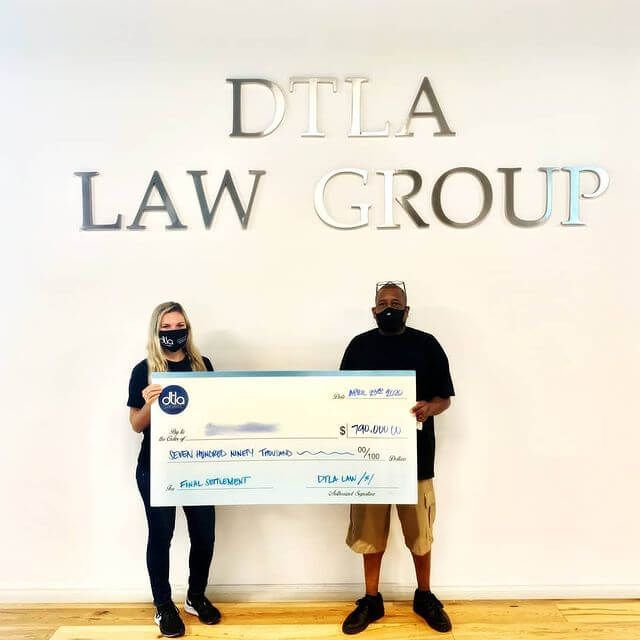
How Do I Find Out the Car That Hit Me Was Driving for Uber at the Time of the Accident – Was on the App
If you have been in an accident with another car, you can find out if the car was an Uber driver. All Uber drivers need to be on the app at the time of the crash, for the accident to be covered by the Uber insurance. Uber is able to cover the cost of the crash, but the Uber driver needs to have been on the app as an Uber driver at the time of the accident.
If you were hit by an Uber driver, you can review Uber driver’s payment history for the lift, and call Uber to discuss the app history that the driver accepted a ride on that particular day and time. This will confirm a record of the driver picking up a fare, and that the driver app was engaged at the time of the accident. The passenger will have been charged by the Uber app, if that individual had accepted a lift from an Uber driver.
How to Know If the Rideshare App Was on at the Time of the Accident
It is possible to contact Uber to determine if the driver was on the Uber app at the time of the accident. Once a passenger trip is accepted, Uber will maintain and offer uninsured or underinsured motorist bodily injury for the behalf of the driver. The Uber coverage will vary by state, but it is going to be at least:
- $50,000 in injury liability per person
- $100,000 in total liability per accident
- $25,000 in property damage liability per accident
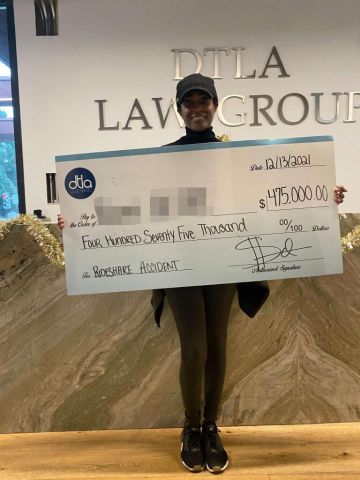
Causes of Uber Accidents
Common Questions
- Who is responsible for most Uber accidents? Human error accounts for over 90% of automobile crashes, so an Uber driver or third-party is most likely responsible for the crash.
- Do I get reimbursed if my Uber driver gets into an accident? You may receive a refund for your trip if your driver was involved in an accident.
Given that Uber is a popular service and the company employs thousands of drivers in already-congested cities, it is no surprise that there are dozens of accidents involving the vehicles each year. Although many drivers are generally safe, there are individuals who make mistakes or carelessly operate the vehicles. Most of the time, the drivers who behave in such a manner likely drove the same way when they weren’t transporting anyone; it is no different that they are driving for money. In fact, the need to complete many fares to earn more wages is a primary factor in many Uber crashes.
Complete a Free Case Evaluation form or call (855) 339-8879 today.
Other causes of Uber accidents include:
Speeding
 Uber drivers may drive recklessly by speeding, which can create dangers for many people on the road. Speeding vehicles have a harder time coming to a stop and drivers have less time to react to sudden dangers on the road, such as cars turning from hidden driveways, vehicles merging, animals darting into the street, pedestrians crossing at crosswalks that aren’t at lights, and more. Uber drivers who speed in residential areas run the risk of injuring more pedestrians, children, and homes, while Uber drivers who speed on highways and freeways raise the chances of severe or fatal injuries in crashes.
Uber drivers may drive recklessly by speeding, which can create dangers for many people on the road. Speeding vehicles have a harder time coming to a stop and drivers have less time to react to sudden dangers on the road, such as cars turning from hidden driveways, vehicles merging, animals darting into the street, pedestrians crossing at crosswalks that aren’t at lights, and more. Uber drivers who speed in residential areas run the risk of injuring more pedestrians, children, and homes, while Uber drivers who speed on highways and freeways raise the chances of severe or fatal injuries in crashes.
Speeding Over Speed Bumps
Unfortunately, speeding over bumps or failing to slow down when approaching a speed bump, can lead to accidents. Taking speed bumps at high velocities can result in the vehicle jolting significantly and can potentially cause the driver to lose control of the vehicle, causing a collision.
Speeding Over Potholes
Typically, drivers try to avoid potholes because they can damage their cars. However, some drivers might fail to avoid potholes or go over them too fast. When drivers speed over potholes, they can contribute to incidents. This is because the vehicle can suddenly jolt and cause the driver to lose control.
Tailgating
Tailgating is the act of driving too closely to other vehicles, which can cause rear-end accidents due to being unable to stop in time. It can sometimes be viewed as an act of aggression, but often, drivers tailgate because they are in a hurry and believe that they are getting closer to their destinations. It does not actually result in arriving faster; in fact, tailgating and having to constantly brake and ease up has been shown to create more traffic than it alleviates.
Running Led Lights
Uber drivers may run red lights if they are in a hurry or need to get to a destination before a deadline. For example, there are times when drivers need to get their passengers to the airport to catch a flight and they take many risks and chances to arrive on time. It is also common for Uber drivers to go through red lights when caught a bit in the intersection or when proceeding through a jammed or packed yellow. Continuing through a light that has already changed is dangerous, and drivers from the opposing direction could get involved in accidents very easily.
Improper Merging
It is common for Uber drivers to go out in packed or traffic-ridden areas, which are usually filled with people who do not exert a lot of courtesy. This forces Uber drivers to be more aggressive and force their way into lanes if they want to enter or exit. Some individuals refuse to give up space, and Uber drivers will try to fit in the gaps. In slow-moving traffic jams, this may simply result in a sideswipe or a less damaging accident, but on freeways where there are plenty of cars traveling at high speeds, an improper merge can lead to a fatal accident. The Uber driver may signal too late, merge too slowly, or cut someone off, which can cause someone in the lane to hit the vehicle.
Running Stop Signs
One of the most common violations that Uber drivers commit on the road is running stop signs. Not every driver runs a stop sign by fully blowing through it and not even coming to a stop. In fact, many Uber drivers simply come to a rolling stop and then proceed as normal. This can be problematic – driving through a stop sign prematurely can throw off the flow of traffic and cause accidents among those who believe they have the right of way.
Right of Way Violations
It is important that drivers acknowledge who has the right of way, but Uber drivers sometimes overstep boundaries and try to ignore the courteous and rightful way in traffic. For example, individuals who have to turn left into oncoming traffic should wait for an appropriate break or for the cars to slow down for them. By speeding through the turn, the other drivers must quickly brake, which can create a chain reaction of accidents, including rear end crashes and swerving.
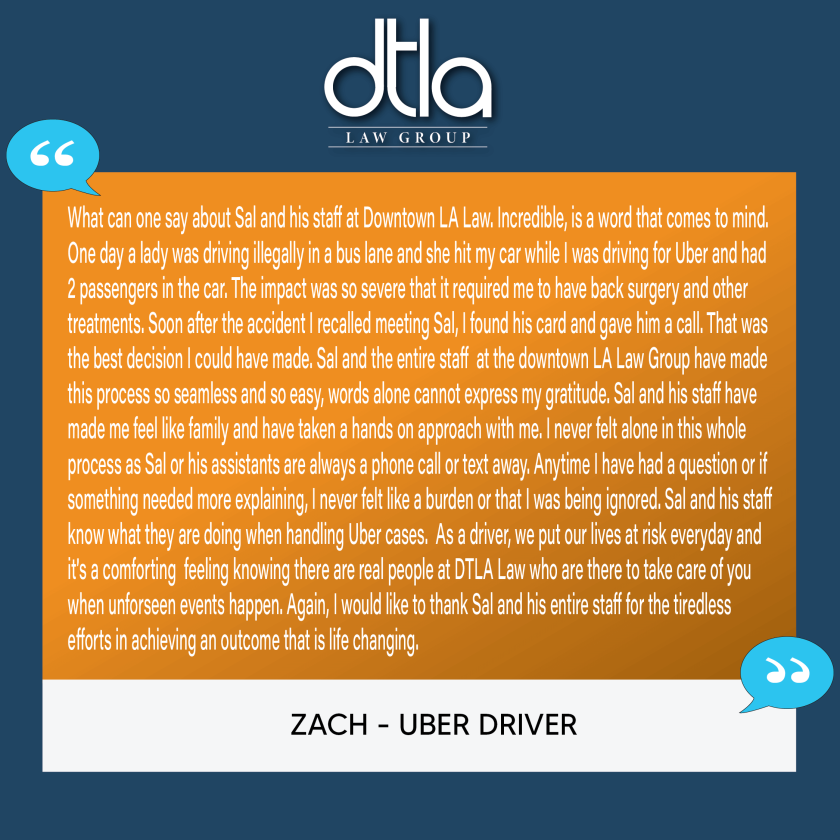
Parking Lot Crashes
Uber drivers often drop people off in parking lots and parking structures if the passengers make special requests. There are very low speed limits in parking lots and Uber drivers must constantly be aware of people pulling out of narrow spaces, coming around tight corners, and walking from in between vehicles and out of doors. Uber drivers who do not pay close enough attention or who speed in parking lots can easily crash.
Drunk Driving
Some Uber drivers make poor decisions and decide to go driving after having a few drinks. This is extremely risky and dangerous, as it doesn’t only place the drivers themselves in danger, but also places the lives of everyone nearby at risk. Drunk Uber drivers have lowered inhibitions, poorer reaction time, and may pass out while behind the wheel. It is illegal to drive with a blood alcohol level of 0.08% or higher, but because Uber drivers have passengers and are driving commercially, they are held to the lowered standard legal limit of 0.04%.
Tired Driving
Another huge issue with Uber drivers and accidents is the fact that many drivers tend to go on the road while tired or exhausted. Fatigued drivers are equally as dangerous as those who have ingested alcohol; falling asleep at the wheel can cause a vehicle to veer off the street or swerve into oncoming traffic. Drivers may get behind the wheel to pick up Uber customers after having long shifts at their primary jobs or after traveling for some time; others will work long shifts that drain their energy.
Using Phone While Driving
There are some instances in which Uber drivers must use their phone, such as when they approve new passengers to join the ride. However, there are times when Uber drivers simply excessively use their phones, such as by remapping or rerouting their GPS directions, replying to text messages or emails, contacting passengers, and more. Texting while driving or using the phone while driving is extremely dangerous, and it is crucial that Uber drivers be held accountable for their actions. Passengers can give low ratings and file complaints if the driver does not drive with any regard for safety.
Vehicle Maintenance
Uber vehicles must adhere to certain standards. If drivers do not take care of the cars, they can be barred from driving for the company. Of course, most of the time, there are no specific Uber engineers or quality assurance workers who travel around the different cities and inspect cars. Improperly maintained vehicles can cause sudden accidents; there can be brake failure, engine trouble, broken lights, no seatbelts, fan belt issues, radiator problems, improperly filled tires, and more.
Weather
Poor weather contributes to more Uber accidents than one would expect. The presence of fog, rain, snow, sleet, storms, haze, and other such conditions can make driving very difficult. Not only does it become more problematic to actually operate the vehicle because of slick roads, but there is also the risk of how other drivers will handle the weather. Even Uber drivers who are extremely careful and defensive in poor weather may be hit by someone who was going too fast through the fog or who was speeding in the rain.
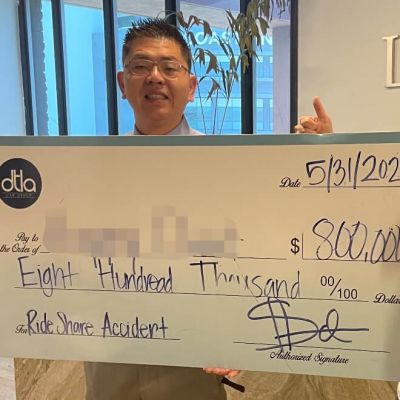
Airbag Malfunction – In Accident / Can I Sue the Rental Company – Lawyer
You may have rented a car from one of the following rental car companies, if you have rented from Uber with an Uber Rental Car. These companies include:
- Avis
- Hertz
- KINTO
- Getaround
- Zipcar
If you have rented a car from Uber Rental Cars and you were in a car accident where the airbag did not deploy, then you may have a serious injury as a result of that accident.
How Does an Airbag Deploy and Why Does It Deploy in a Car Crash?
Airbags were put into cars to help make cars safer in a collision. An airbag is a standard safety feature today in all vehicles. Let’s put our engineering hat on for a moment here, to discuss and understand what happens when there is an airbag that deploys in a vehicle. During a crash, the airbag is meant to slow the driver and front passenger’s speed, while in the vehicle during an accident. The airbag is meant to stop the person from accelerating during the accident. The airbag placement on the wheel, dashboard or side impact near the windows, are there to fill the space between the car and the passenger. During an accident, the person in the car will continue to accelerate and then immediately stop once there is a collision with another car. In that case, the airbag will help the person in the vehicle to slow down accelerating at a safe speed, to prevent a sudden impact situation for the driver or passenger going through an accident event.
The airbag uses the thin nylon fabric of the bag, the sensor to tell the airbag to deploy and open, and the sodium azide (NAN3) reaction with potassium nitrate (KNO3). This chemical reaction makes nitrogen gas, and it is the hot blast of the nitrogen gas which serves to inflate the air bag system. In this case, airbags are like rockets, using a burning solid propellant that creates gas to inflate the airbag. Airbags deflate in literally seconds, and burst open up to 200 mph! Once the airbag is open, the gas seeps out on purpose through small holes in the bag. The deflated bag has done its job to top the people in the vehicle from being injured, and it will then naturally deflate. Airbags in cars today will deploy with much less force than earlier airbags.
Airbags That Don’t Deploy in an Uber Rental Car Can Cause Serious Accidents
If the airbag does not deploy in an accident, then the passengers of a vehicle are not protected at all from the physical forces of a car crash. People in car accidents with undeployed airbags face a high risk of injuries, because there are no safety airbags to prevent an injury during a car accident.
If you have been in an Uber Rental car and had an accident where the airbag failed to deploy, you need to give us a call today. Just call us at the DTLA Law Group, we will be here to help you with your claim. Your injuries could be serious, and we want to help you get the recovery compensation that you deserve in this case.
“Help, I Was Seriously Injured in an Uber Rental Car with No Airbags!”
In the event that you are injured in an Uber Rental car with no deployed airbags, you may have suffered a serious injury. If the airbag did not deploy, it will impact the crash severity. You can suffer being ejected from the vehicle, hitting the sides of the inside of the car, or other serious injuries with no airbag protection.
The airbags are put in a car for a major safety feature – to keep you safe in the event of a car crash. If these airbags do not deploy, you are going to be hurt. If this has happened to you, you need to call our legal team at the DTLA Law Group today. We are here for you and can discuss your claim and personal injuries right now.
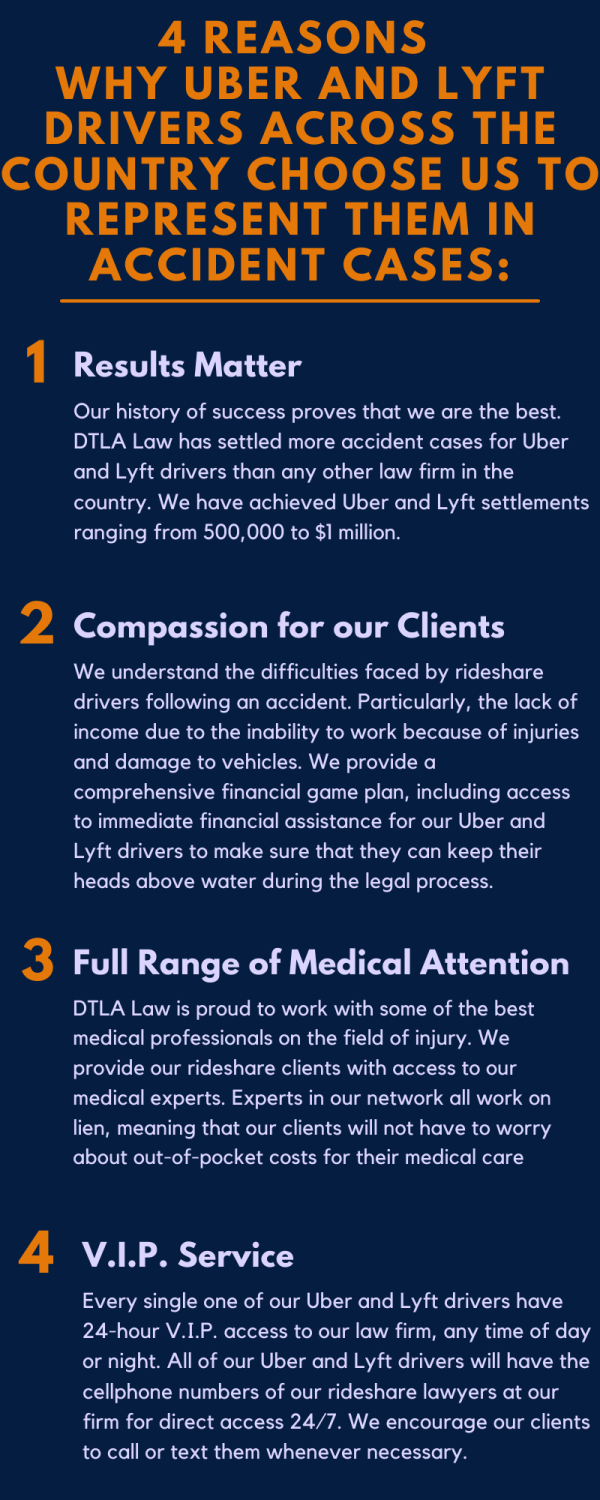
Forcibly Kicked Out, Thrown Out and Removed from An Uber/Lyft by the Driver
Can I Sue for An Uber or Lyft Driver Kicking Me Out of the Car
Yes, you can sue for an Uber or Lyft driver kicking you out of the vehicle. People who are kicked out of an Uber/Lyft vehicle sustain many serious injuries. If a person is kicked forcibly out of a rideshare vehicle, it is typical to have uncommon run-over injuries, crushing injuries and serious injuries that are typical of fractures to the body. If you are kicked out of a car, you can sustain:- Crushing fractures in the feet, arms and legs
- Crushed lacerations
- Underlying major damage to the blood vessels
- Abrasions to the hands, knees, legs, face and arms
- Road rash or road burns to the limbs
- Pelvic and hip fractures
- Internal bleeding in the abdomen
- Crushing injuries to the spine being run over by a car
- Crushing injuries to the legs, arms, hands and feet
- Amputations of arms, legs and fingers
Do I Have a Case and Is There a Lawyer Who Can Represent Me?
Yes, you have a case for your serious personal injuries sustained from being kicked out or forcibly removed from an Uber or Lyft vehicle. Our law firm is able to represent you, we are able to manage your case to a successful conclusion, and are ready to talk to you today about what did happen to you in an Uber or Lyft car. Many people who are forced from an Uber or Lyft car have sustained crushing injuries. Often after a crushing injury, the skin in the area of the trauma starts to die. This will require painful skin grafting in an attempt to save the person’s use of the limb. If there is permanent tissue damage and lack of blood flow to the arm or leg or area of the crush injury, that limb may need to be amputated. The microvascular flow of blood into the capillaries needs to be maintained at a constant rate, or the tissues start to die from lack of blood supply. There can be permanent damage to muscle tissue in less than 8 hours. That is where the decreased blood flow will increase muscle necrosis and metabolic acidosis and hyperkalemia will result, causing toxins to the body which can be fatal. A person with a crushing injury is highly likely to die from the result of those injuries, if there is no immediate medical care available. There is a serious and life-threatening process that occurs in the body after a crushing injury. The muscles will start to die from a lack of blood flow, and will emit toxins to the blood. These toxins react to the organs and can cause renal dysfunction, issues with flood flow and can cause complications such as:- Cardiotoxicity
- Renal failure
- Sepsis
- Multi-organ failure
- Death
Can I Sue Uber and Do I Have a Case? What Are My Rights as a Passenger?
Yes, you can sue Uber and Lyft, and you have a case, as well as rights as a passenger not to be hit by an Uber or Lyft car, and not to be injured while leaving the Uber or Lyft vehicle. You need to talk to an attorney immediately if this situation has happened to you. If you have been forced from an Uber or Lyft car, you need to call our law office right away. Our legal team will work with you when you call, to develop your case based on your situation. We are ready to take your questions, and explain everything to you related to a lawsuit, regarding your personal injuries that are the result of this type of accident. You may even still be in recovery mode from your personal injuries – you should still call us right away.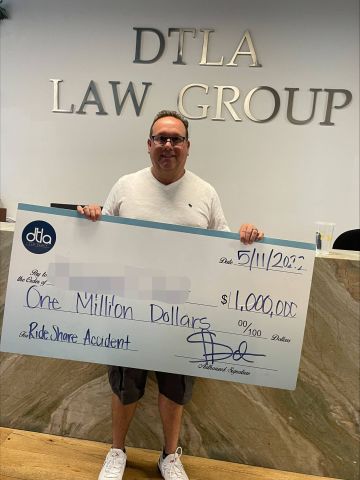
Common Injuries from Uber Accidents
Common Questions
- Will Uber cover my injuries if I was hurt in an accident? Yes, liability for injuries to third parties is coverd under Uber’s insurance.
- How dangerous are Uber rides? Uber rides are no more or less dangerous than any other drive you would take.
An Uber crash can range from being a mere fender-bender with no apparent or serious injuries to a multi-car pileup with numerous fatalities. Some accidents that may appear to have severe consequences may actually yield no damage at all, while seemingly innocuous crashes could result in heavy injuries. Some of the various injuries that have resulted from Uber accidents include the following:
Bone Damage
 Fractures, breaks, cracks, and crushing injuries can all permanently affect the way you use your body. A broken bone may not set properly and heal wrong, which could limit the range of motion for the rest of your life despite physical therapy and repairs. Broken bones and other damages can also increase the amount of time you spend recovering and could easily put you out of work for weeks. Crushing injuries could also shatter the bone and leave it permanently disfigured; victims may suffer crushing injuries when their hands, feet, and other body parts are caught between the vehicle and the seat, door, window, and more.
Fractures, breaks, cracks, and crushing injuries can all permanently affect the way you use your body. A broken bone may not set properly and heal wrong, which could limit the range of motion for the rest of your life despite physical therapy and repairs. Broken bones and other damages can also increase the amount of time you spend recovering and could easily put you out of work for weeks. Crushing injuries could also shatter the bone and leave it permanently disfigured; victims may suffer crushing injuries when their hands, feet, and other body parts are caught between the vehicle and the seat, door, window, and more.
Muscle Injuries
Sprains, strained muscles, tears, and more can damage numerous parts of your body. Knee injuries, such as LCL, ACL, and MCL tears, can take months to properly heal, and in that time, you may be extremely sensitive and suffer a lot of pain while walking. You could suffer a torn rotator cuff, which is an extremely common shoulder injury in Uber accidents as your shoulder is directly next to a door.
Brain Injuries
The sudden impact can cause your head to crash off the window or steering wheel, and even moderate damage can cause irreversible brain damage. Victims may suffer concussions, which can cause haziness, dazed behavior, memory loss, dizziness, trouble concentrating, sensitivity to light and sound, and more. A concussion – or worse, a traumatic brain injury – can make victims unable to drive or work. Closed head injuries, such as brain bleeds, cracked skull, and others, can also be detrimental to brain health.
Internal Injuries
Because of how vicious an Uber accident can be, some victims may suffer intense internal damage. There may be bleeds, liver damage, kidney damage, heart trouble, collapsed lung, intestinal injuries, and more. Some of the injuries may be exacerbated during treatment or may occur as a result of surgery. Of course, if an organ is removed, it could lead to a change of life; removal of a gallbladder may not change much, but removing part of a lung can drastically impact day to day activities and recreational habits, if not job capabilities.
Neck and Spinal Cord Injuries
Neck injuries are common in Uber accidents because of how fragile the neck is. A crash can cause whiplash which is a condition where the neck suddenly swings due to impact. There can also be spinal cord injuries; spinal cord injuries are extremely problematic because of how crucial the spinal cord is to movement and for transmitting information to the rest of the body. There is the chance that the discs in the back will get herniated or slip out of place in the accident. If these disc issues do not get resolved, treatment can eventually necessitate surgery, which would require the discs to be fused to the spine, thus preventing mobility and increasing stiffness.
Severed Limbs
Circumstances in Uber crashes can cause victims to lose limbs and digits. Some people may have their hands and arms outside of the window when they are struck by a vehicle and others may have their legs pinned or crushed beneath broken seats or caved-in doors. The limbs may not get any blood flow and may have the tendons, bones, nerves, and other crucial parts mangled beyond repair. There may be no hope for repair and only a prosthetic limb can be used to return to normal. These victims may have to live with phantom pain, lingering nerve damage, and more. They will also need intense and lengthy physical therapy and must learn how to live without a limb, which could completely change their lives. Additionally, prosthetic limbs and treatment for such injuries can be extremely costly, and health insurance may max out and not cover all the expenses eventually.
Permanent Injuries
Although severed limbs are permanent injuries from Uber accidents, there can also be burns that result in scarring, facial damage like loss of eyes, need for facial reconstruction, coma and brain damage, and more. These permanent injuries wreak havoc on family and friends, and victims will never be the same as they were before.
Paralysis
Paralysis can take on many forms. In the least impactful cases, only parts of the body are paralyzed or numb, such as fingers and toes. However, the more intense forms of paralysis include paraplegia, which is the loss of function in the legs, and quadriplegia, which is the loss of function of all limbs and body parts below the neck. Those suffering from paralysis are often confined to wheelchairs and must learn to adapt to a new lifestyle. Their homes must be restructured or have additions tacked on, they must purchase new vehicles that are handi-capable, and much more.
Speed bumps and Pothole Incident Injuries
When drivers take speed bumps or potholes at high rates of speed, passengers riding in the vehicle can potentially suffer significant injuries. These injuries are caused due to the sudden jolting of the vehicles that occurs when speed bumps or potholes. The injuries related to these incidents can include the following: head injuries, traumatic brain injuries, concussions, skull fractures, facial fractures, broken nose, facial lacerations, neck injuries, etc. These injuries occur when passengers hit their heads on the ceiling of the vehicle, on the side panels or windows, or on the seat in front of them.
Although the incidents are different, they can result in much of the same injuries. Unfortunately, these incidents are often disregarded as only minor, so the injuries that victims suffer are also often overlooked. All of the injuries mentioned above, however, could result in long term harm to innocent passengers.
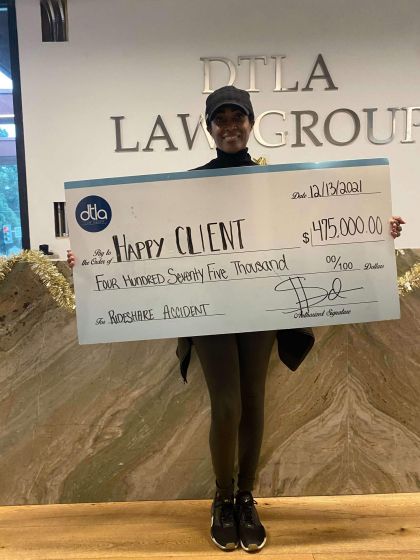
Uber/Lyft Door Injuries
In some instances, rideshare injuries are possible without actually being involved in a crash. These injuries could occur as a result of door incidents – specifically, from vehicle doors being shut on body parts. The most common injuries stemming from door incidents include broken fingers, crushing finger injuries, hand injuries (including fractures and sprains), lacerations, nail injuries, bruising, etc. In addition to these injuries, leg and foot injuries are also possible, including fractures, sprains, crushing injuries, and toe injuries, for example. If the door injuries occurred during an active rideshare ride, then the rideshare company could be liable for the harm suffered.
Death
There are over 30,000 deaths per year from car accidents, and Uber accidents themselves have resulted in many different crashes where individuals have passed away. Victims have died at the scene of the accidents and have also perished in the aftermath during treatment from lingering damage. They may have suffered extreme bodily trauma, loss of blood, brain damage, and more. Many similar injuries can also occur if you fall from an Uber Jump bike or scooter or if you are struck by these vehicles. In the event that you are struck by an Uber car while walking on the street, you could suffer much worse damages. Pedestrians are not as protected as passengers in vehicles; they do not have seatbelts, cushions, and other forms of safety. These individuals may be left in worse conditions and could be hit by other vehicles passing by.
List Of Steps To Take After An Uber Accident
Common Questions
- If I can’t take pictures at the scene of the accident, can someone else do it for me? Yes, you can have a friend or witness take photos for you.
- What if the Uber driver doesn’t report the incident? You should always make sure to report the accident to Uber just in case the driver tries to hide it to prevent any action, such as getting barred from driving or from paying an insurance claim.
- Do I have to file a police report?
- Do I have to file an accident report if I was injured as a passenger in the Uber/Lyft accident?
- Do I have to file my own police report?
If you were a passenger in an Uber or Lyft vehicle when the incident occurred and you suffered injuries, you definitely need to file a police report. Although most importance is given to drivers making their reports, passenger reports are also of great importance.
Yes, you should file your own police report. Ensure that you provide the police with as many details that you remember leading up to the incident. You should also request a copy of your police report. It is important that you file your police report immediately, as it will be an important piece of evidence when you are filing the incident report with the rideshare company.
 It may be very confusing to act appropriately after an Uber accident. You could be troubled, hurt, or unsure of how to proceed. It is crucial that you do not leave the scene of the accident no matter if you are a passenger, Uber driver, or other individual involved in the crash. You should stay until the police arrive or until you have gathered appropriate evidence and information. Fleeing the scene of an accident is a crime, and you could be hit with legal consequences, ranging from a misdemeanor to a felony. The general steps to take after an Uber accident are essentially the same no matter what position you were in. Some may differ slightly, but not too extremely.
It may be very confusing to act appropriately after an Uber accident. You could be troubled, hurt, or unsure of how to proceed. It is crucial that you do not leave the scene of the accident no matter if you are a passenger, Uber driver, or other individual involved in the crash. You should stay until the police arrive or until you have gathered appropriate evidence and information. Fleeing the scene of an accident is a crime, and you could be hit with legal consequences, ranging from a misdemeanor to a felony. The general steps to take after an Uber accident are essentially the same no matter what position you were in. Some may differ slightly, but not too extremely.
- In the immediate aftermath of an Uber accident, get medical attention as quickly as you can. Victims may sometimes not feel as though they have been severely injured or may not notice certain injuries. Paramedics called to the scene of the accident can check your health and determine how hurt you are. You may be transported to the emergency room for urgent surgery and treatment, or you may simply be able to go home and see a doctor later. If you plan to file a lawsuit, this initial period of medical attention is extremely important to your case. If there is a noticeable gap between the accident and the treatment you received at the doctor’s office, the insurance agent handling the claim could state that you were not as injured as you proclaimed or that you were hurt in another incident and you are trying to use the Uber crash to collect compensation for separate injuries.
- You should have ample proof of your medical treatment and the damages you suffered. The hospital or healthcare facility will give you a receipt or a bill that details the services you had done at the hospital. You may also request to keep the notes from the paramedics.
- In addition to medical proof of your damages, you should also have ample documentation and photos. You should take pictures and videos from different angles and at different times after the accident. If you can show how injured you were and the extent and impact of the injuries, your evidence will be much stronger.
- Ample photos that also document the circumstances of the case can be worthwhile for your evidence. You may take photos of the scene of the accident to show a few problems or issues. For example, the road may have had a large pothole in it or there may have been debris in the street. There may not be adequate lighting from street lamps and there could have been bad weather that completely clouded vision or caused the environment to become dangerous to drive through. You can also document the state of the vehicle and the damage to any other cars or objects. This can serve as a way to identify the angle of impact, and thus, some degree of responsibility. For instance, if the Uber vehicle were rear-ended, you should photograph the rear of the car and the front of the other one.
- If you were a passenger or a driver, your Uber app will have the details of the trip. You should screenshot the trip information, name of all parties involved, and the payment information. This information will show that you were a rightful customer or lawful driver in the incident.
- Beyond the information gathered on the Uber app, you should collect necessary contact details and insurance details from those involved. Drivers should exchange information and parties should be sure to file a claim in a speedy and efficient manner.
- There were likely other individuals nearby who saw the accident happen. They may have been at store, walking on the street, or even been in other cars as passengers. You should interview these eyewitnesses and take down their statements and testimonies to have additional evidence for a claim. This will cut out a lot of the dissenting opinions on who was responsible and who was carelessly driving. In addition to bystanders, you could ask nearby businesses if they had security cameras installed; the surveillance footage could show the incident happen and provide crucial evidence.
- In some Uber accidents, especially those that occurred on the freeway or resulted in physical injuries and the presence of paramedics, the police may come to the scene. They will likely conduct an investigation to see if there were any criminal activities; for example, one of the drivers may have been under the influence of drugs or alcohol or he may have committed some kind of violation while driving. The police will interview all those involved and will file the report at the station. Once it has been finalized, you can ask for a copy of the report.
- You should alert Uber to the accident so that they cannot deny any liability or knowledge of it. There is a section on the app that allows you to report a serious incident involving a driver. You must provide the date, time, and location of the incident, as well as the rider or driver name. Other additional details can be submitted.
Common Questions
-
Do I have to file a police report?
-
Do I have to file an accident report if I was injured as a passenger in the Uber/Lyft accident?
-
Do I have to file my own police report?
If you were a passenger in an Uber or Lyft vehicle when the incident occurred and you suffered injuries, you definitely need to file a police report. Although most importance is given to drivers making their reports, passenger reports are also of great importance.
Yes, you should file your own police report. Ensure that you provide the police with as many details that you remember leading up to the incident. You should also request a copy of your police report. It is important that you file your police report immediately, as it will be an important piece of evidence when you are filing the incident report with the rideshare company.
Uber’s History with Drivers
Common Questions
- Why do companies hire independent contractors? Independent contractors are usually hired because they are cheaper than employing full time workers and because they provide services that the company may not offer.
- Do Uber drivers get benefits? Uber drivers are not offered the same types of benefits that full time employees are offered.
Find out more about how we can help you. (855) 339-8879 with a representative now.
Additionally, Uber drivers, if they were considered full or part-time employees, would be subjected to various labor laws. They would have the right to minimum wage, anti-discrimination laws, tax withholdings, unemployment benefits, worker’s compensation benefits, mandated meal breaks, and more. Uber contested that because its drivers set their own hours and is free from the control and boundaries of the company, they are not full time employees and are essentially freelance workers. The labor office of California was one of the first to grant Uber drivers damages owed by the company and stated that there are numerous examples of the business acting like an employer. In 2015 and beyond, various rulings set the stage for the unfolding landscape of the future of Uber.Common Questions
- Has Uber been sued before? Yes, Uber has been sued by accident victims, drivers, cities, and more. Laws have been created and changed because of the impact Uber has had on the economy, worker’s rights, and the current state of transportation on the road.
2013 Vehicular Manslaughter of 6-year-old Girl
Syed Muzaffar was driving his Honda Pilot, a sport utility vehicle, when he approached the Civic Center in San Francisco on New Year’s Eve in 2013. The 57-year-old had dropped off one individual earlier and planned to take more fares as the night went on, transporting people around the city, as the holiday was guaranteed to bring in a lot of fares. In between rides, Muzaffar was in the Tenderloin district when he failed to notice a family crossing the street at a crosswalk. He negligently turned into the crosswalk during a green light and struck the Liu family, killing the 6-year-old daughter in the process and greatly injuring the mother. The mother required an extensive stay in the hospital and eventually underwent surgery to repair her damaged eye. Muzaffar was charged with vehicular manslaughter some years after the incident. The contents of the case were primarily focuses on the level of negligence Muzaffar displayed at the time of the crash. Although he had the green light, he did not have the right of way on the turn; the Liu family was proceeding through the crosswalk as they rightfully should have. Muzaffar’s defender said that the fact that the lights changed at the same time contributed to the crash. Additionally, the mother who was struck claimed that Muzaffar was continually looking at his phone and back to the street, and that the light from his phone illuminated his face. It was confirmed by Uber that Muzaffar was in between fares and was waiting to accept a ride. According to the company, he had no reason to be looking at his phone repeatedly. After deliberation, Uber reached a settlement with the Liu family for a sum of money that was not disclosed by the courts. The accident was the main catalyst behind the change in Uber’s insurance system, branching out to cover drivers who were in between fares and logged into the app while waiting for a customer to request a ride. A large issue that was discovered with the incident was the fact that Muzaffar had previously been convicted of reckless driving in Florida some years before. However, the background check was limited to information from no later than 7 years beforehand, and California law prevented the company from learning about the previous conviction.2015 Ruling for Driver Reimbursement
In 2015, Barbara Ann Berwick took Uber to court for reimbursement for wages she earned in 2015. The wages and expenses totaled over $4,000. She had taken on the job to supplement her regular income at a trading company, for which she spent a lot of time at her computer. She claimed that she was essentially paid less than minimum wage for her driving. A California court ruled in her favor and awarded her the damages she sought. However, at the time, there was no blanket ruling that would allow other drivers who suffered the same fate to be automatically reimbursed for their lost wages or to receive what they were owed. Instead, it was a situation that would likely result in many small lawsuits from drivers, even culminating in a class action claim.Ongoing Class Action Lawsuit
What initially started in California has spread to other parts of the country. Uber drivers collectively filed a class action lawsuit that challenged the notion that Uber classified them as independent contractors or freelancers and would thus be exempt from certain business practices. Despite Uber offing insurance coverage thanks to a previous ruling, the company is still fighting against categorization of its drivers as employees.Incident with Blind Passengers and Service Dogs
In 2016, three different blind passengers joined a class action claim against Uber that resulted in them getting $15,000 a piece for the actions against them. Uber drivers denied these blind passengers the ability to ride because they had service dogs and guide dogs with them. The drivers did not want animals in the vehicles and refused to accommodate the blind passengers. This is a blatant violation of the Americans with Disabilities Act that requires service dogs to be allowed wherever the afflicted owners are going. Uber drivers are not exempt from this rule, but there is speculation that many simply do not know it exists. They merely see a dog and may want to keep their interiors clean and have a kneejerk reaction. Drivers who do not agree to transporting service dogs or allowing guide dogs onto the ride will be barred fro picking up customers until they agree. As a result of the incidents, Uber paid out an additional $225,000 to the National Federation of the Blind.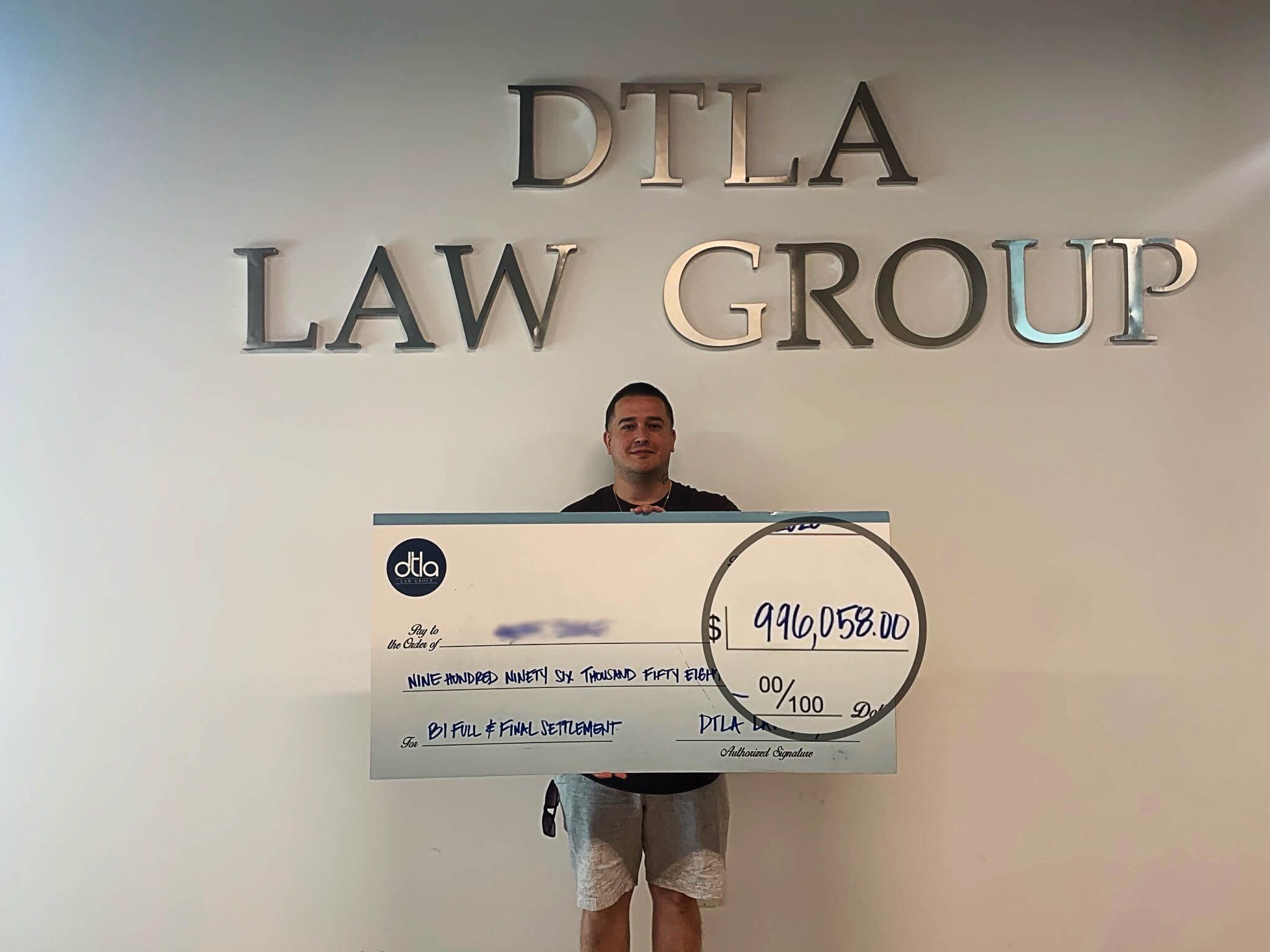
Types of Uber Accidents
Common Questions
- Can Uber be held responsible for an accident with any of their services? As long as Uber had a part in the incident in some way, yes, they can be held responsible.
- If an Uber vehicle malfunctions, what can I do? You should be sure to document your evidence accordingly so that you can prove that the Uber vehicle malfunctioned, and then file a claim for reimbursement or compensation if you were injured.
Given the breadth of Uber as a company, it is no surprise that there are numerous ways that accidents can happen. The different transportation options that Uber offers increases the rate of accidents simply based on numbers alone.
Bikes
Uber’s JUMP branch provides electric bikes for use across various cities. The bikes can be made to go faster the harder you pedal. They can be unlocked for free and cost 15 cents per minute to ride. They can be placed on hold for up to one hour (and your account will be charged during that time); when you’re finished, you simply lock the bike and go about your business. There is also a Boost Plan offered by Uber that allows drivers one hour of ride time per day. It costs $5 per month, 7 cents per minute after the initial 60 minute ride, a $25 fee if the bike is parked out of the system, and more. It can be used by individuals enrolled in certain programs, such as Medi-Cal and CalFresh. Bikes must be ridden in bike lanes and not on the sidewalk. Because they are electric and may malfunction while being ridden, it is very possible that riders can get in accidents with other people.
Scooters
JUMP scooters can be reserved or unlocked in the same way that bikes can. They cost $1 to unlock, though, but run the same 15 cent charge thereafter, except after 5 minutes of ride time. They can be left anywhere within the appropriate zone (scooters left outside of the zone incur a $25 pick up fee). As with all scooters in California, there is a set of rules that must be abided by when on the vehicles. You must be over the age of 18 to ride, ride in bike lanes, have a valid US driver’s license, and obey all applicable traffic laws (yield, ride within speed limits, do not leave the scooters on the sidewalk or in the street when they’re not ridden, have at least one hand on the scooter, do not ride while inebriated or distracted, only have one person on the scooter at a time, and more). Because scooter riders are usually zipping around the beach and in areas with a lot of traffic, they may not be paying attention to all of their surroundings. A scooter accident can be problematic for a rider, as they have essentially no protection besides the mandated helmet, and equally as troublesome for victims. They are quite mobile and fast compared to pedestrians, and accidents can happen very quickly.
Cars
The most common form of Uber accidents occur with rideshare vehicles. Almost any type of vehicle can be an Uber car; there are compact coupes and large SUVs driven by workers, and everything in between. You can select your ride type at the start of the Uber interface and the car will come to your location within a few minutes. Trips are generally a few dollars and cost more when you need more seats or additional passengers. You should be aware of all the normal traffic rules and regulations, whether as a passenger or driver. You should always wear a seatbelt and avoid any reckless behavior. Uber drivers may be in a rush to finish fares, especially if they are going to certain bus areas. For example, if a person requests a ride to the airport and the fare is only 5 dollars, there is a chance that the ride will take as long as an hour. This entices drivers to speed and drive carelessly in an attempt to squeeze as many fares into a shift as possible. Further, Uber drivers are responsible for the care and maintenance of their own vehicles. The more a car is used, the more wear and tear it suffers, and thus, the risk of accidents stemming from malfunctions rises.
Incidents Worsened by Defective Airbags
Car accidents involving rideshare vehicles are, unfortunately, quite common. Vehicles are equipped with airbags which are supposed to deploy during collisions to reduce the risk of severe injuries. However, airbags can fail to deploy. Defective airbags can lead to severe and sometimes fatal injuries in car accidents. If your airbag failed to deploy, resulting in injuries, then you might have grounds to file a lawsuit against the auto manufacturer for the harm that you suffered.
Pedestrian
Pedestrians may very well be in harm’s way with all the Uber vehicles traveling the streets. Pedestrians are seemingly unsafe everywhere. There are many individuals who are in danger due to bikes and scooters that riders operate on the sidewalks or on the beach, where they go too fast for comfort. Pedestrians also have to worry about Uber drivers not paying attention while behind the wheel because they are using the app, picking up new passengers, inputting different GPS directions, answering messages, and more. It is recommended that pedestrians grow accustomed to areas that are hotspots for Uber vehicles and exercise caution in those regions. For example, if a specific cross-street is a popular pool pick up location, pedestrians are advised to walk elsewhere or be extremely careful when traveling. The majority of pedestrian accidents occur when the individual is walking in the crosswalk and an Uber vehicle turns on red or turns into the intersection. The driver may not have been paying close enough attention or the pedestrian may have been in his blind spot. No matter what, though, the driver can be held responsible, as can Uber. It is extremely rare for the pedestrian to be held accountable for an accident.
Assaults
Perhaps the most troubling type of Uber accident involves assault and sexual assault. Uber was largely used as a way for inebriated individuals to return home after a night out. In some cases, people went back to their apartments and were followed inside by the Uber drivers, or else they were outright harassed or assaulted inside the Uber car itself. The trouble with many assault cases is that Uber drivers may have a history of aggravated behavior, but it may not have been picked up by the background check, or the driver may have been reinstated despite previous complaints. He may even have circumvented the system and managed to get back onto the app himself. Assault victims may be traumatized and swear off the app and similar services. Worse, they may not take any legal action against the drivers or even report them to the company – which could leave the door wide open for future transgressions and attacks.
Does Uber do background checks of sexual assault of its drivers? Does Uber conduct background checks on its drivers for criminal activity, arrest records, prior accident, accident records, etc.? Yes, Uber conducts background checks. All prospective drivers are subjected to extensive background checks to identify issues with driving history and criminal history, for instance. When background checks come up clean, drivers are clear to drive for Uber. Existing drivers are also subjected to random background checks; if any secondary checks are problematic, then they are not allowed to continue to drive. Unfortunately, however, background checks are not always effective. Background checks only flag those who have been caught in one way or another, whether they were arrested or charged for something, for instance. Any driver that has consistently gotten away with things will not be flagged. In addition, some red flags with background checks can be missed by both system error and human error. Although Uber does subject their drivers to background checks, sometimes that isn’t enough to reduce the risk of harm to passengers.
Sexual Harassment
Unfortunately, many people do not take action after being sexually harassed. Even if sexual harassment does not escalate to assault, it is important for affected parties to take action. Sexual harassment in rideshare is a serious issue. We have received some of the following questions:
- My Uber driver asked me to have sex in exchange for money. Is that sexual harassment?
- My Uber driver made a pass at me. Is that sexual harassment?
- My Lyft driver asked me to have sex with him in exchange for a free ride. Is that sexual harassment?
- I was afraid for my safety after my driver made unwanted sexual advances towards me. What can I do?
- I was afraid for my life after my driver started saying sexually explicit things to me. Is that sexual harassment?
- Can I sue Uber or Lyft after one of their drivers sexual harassed me?
- Do I have a case for sexual harassment against Uber or Lyft?
- What are my rights if I was sexually harassed by my driver?
Sexual harassment can be defined as any unwelcomed sexual advances, requests for sexual favors (including those in exchange for something), jokes of a sexual nature, unwanted touching, discussing sexual fantasies/relations, exposing oneself, unwanted sexually explicit photos/messages for example. If your Uber driver or Lyft driver made a pass at you or asked you to have sex, that definitely classifies as sexual harassment – and yes, you could have a case and sue Uber/Lyft.
Can I report to Uber? Can I report to Lyft? Yes, you can definitely report sexual harassment to Uber and Lyft. If you would like to learn more about your rights to sue Uber or Lyft after you suffered sexual harassment during a ride, you should seek legal assistance immediately. Where can I find a lawyer that can help me? Here at Downtown L.A. Law Group, our lawyers are more than ready to evaluate your Uber/Lyft sexual harassment claim and help you recover a fair compensation for the harm that you suffered. Do not hesitate to contact our experts at your earliest convenience.
Broken Wheelchair Ramps
Uber offers wheelchair accessible vehicles to users who depend on wheelchairs and scooters for mobility. Although this wheelchair accessible Uber option is undeniably beneficial, it has also resulted in the increase of incidents related to wheelchair ramps. Broken ramps, defective ramps, and driver fault (e.g., pushing the wheelchair up the ramp too forcefully, pushing the wheelchair before the ramp is ready, etc.) can all lead to incidents – specifically causing the passenger to fall off the wheelchair or fall off the ramp.
If you fell of the wheelchair or fell off the ramp while getting on the Uber accessible vehicle, you might have many questions. Can I sue Uber if I was injured while getting on or off the Uber wheelchair accessible vehicle? Yes – you could have grounds to sue Uber and potentially recover monetary compensation for the harm that you suffered. For more information about the legal options available to you after being injured in a ramp incident while getting on or off an Uber wheelchair accessible vehicle, do not hesitate to contact the experts at our law firm immediately. Our Uber accident attorneys are ready to provide you with the guidance that you need to fight for your rights and recover the compensation that you are owed.
Legal Rights Of Victims
Common Questions
- What are my rights if I am on the road? Essentially, all individuals on the road are entitled to a safe trip and must not be placed in harm’s way by any drivers or operators of vehicles.
In Uber accidents, there are different people who can be affected. Let’s look at some of them.
Uber Drivers
Uber drivers can be involved in accidents the same way that other individuals are. They may be hit from behind, cut off, sideswiped, T-boned, and more. In the event that there is an accident with another car, Uber drivers can take legal action against the responsible party’s insurance agency to receive compensation for their damages. If the responsible driver does not have adequate coverage, the worker can turn to Uber for coverage options. This uninsured/uninsured motorist coverage allows Uber drivers to have some medical bills paid and for their vehicles to be repaired if the opposing drivers flees or if he cannot pay the full extent of the damages.
Uber Passengers
Uber passengers are almost never at fault for an accident given the fact that they are merely customers in the service. They may have been asleep, on their phones, intoxicated, or otherwise minding their business when the accident happened. Regardless of who caused the crash – an Uber driver or another vehicle – the passenger could be aptly reimbursed for subsequent damages. He can take legal action against the opposing driver if a third-party hit the car; he could also take action against the Uber driver himself; or he could potentially file a lawsuit against the company.
A Common Issue – Passengers Not Wearing Seatbelts
Some passengers are not wearing seatbelts at the time the accident. Whether this is because the passenger simply forgot to put on the seatbelt or chose not to put on the seatbelt, the passenger might be asking him or herself the following question – can I still sue if I was not wearing a seatbelt and was injured as a passenger in an Uber or Lyft accident? Yes, you can still sue. Can I get recovery if I was not wearing a seatbelt and was injured as a passenger in an Uber or Lyft accident? Yes, you can still get a recovery; however, your recovery is likely to be affected.
What are the passenger injury laws that apply when not wearing a seatbelt at the time of the accident? In the state of California, you can file a lawsuit if you were injured in an accident even if you were not wearing a seatbelt. Even though not wearing a seatbelt is against the law, breaking this law does not void your right to sue. How can not wearing a seatbelt affect your claim? California is a comparative negligence state; therefore, if you are found to have been negligent in one way or another and to have contributed to your injury, then the value of your claim can be affected. For more information about whether you could sue even if you were not wearing a seatbelt when the Uber or Lyft accident occurred, do not hesitate to contact the experts at our firm immediately.
Third-parties
Third-parties are those not directly involved in the Uber ride but are affected in the accident. If your Uber driver crashes into another vehicle or an individual, the affected individual is the third-party. It is possible that a third-party can take legal action against Uber for the actions of the driver, especially if there were severe injuries as a result of the incident.
Uber’s Partner Insurance Policies and Information
Common Questions
- What is liability? Liability insurance covers physical injuries caused to other individuals, not damages to your vehicle or injuries you yourself suffered.
- What is collision coverage? Collision insurance protects your vehicle by repairing or replacing it after it was involved in an accident with another car or object.
- What is comprehensive coverage? Comprehensive insurance covers anything else that is not a result of an accident with a vehicle or some kind of collision. This includes storm damage, vandalism or intentional destruction, animal accidents, and more.
- How long does it take to hear back from Uber’s insurance?
- How much time do I have to wait to hear back from Ubers Insurance for an accident claim?
In order to drive for Uber, prospective workers must have complete automobile insurance coverage on all of their vehicles they intend to use for rideshares. Your liability insurance must be equal to or greater than the minimum requirements for your state. Possessing auto insurance coverage makes you eligible to drive for Uber – and Uber grants you its own coverage, as provided by James River Insurance. The reason that Uber has its own insurance policy for its drivers is simple. Personal auto insurance carriers do not protect drivers when they are driving commercially, or for money. In many cases, if an insurance company discovers that one of their policyholders was driving for money while covered under their policy, they will drop the driver. The insurance coverage will not kick in if there is an accident of some kind. Thus, companies and businesses that employ drivers often provide their own insurance. Uber’s insurance coverage is a unique system that has two parts to it. Uber drivers that are not technically working or on the clock are protected by their own regular insurance policies. However, once they turn on the app and await a customer, you are then protected in the following ways:
- $50,000 in driver liability for bodily injury to one individual
- $100,000 per accident
- $25,000 for property damage caused to other individuals
Upon accepting a trip to the time that you pick up the passengers and drop them off, the insurance policy will shift to the second part, which takes precedence over the first. This policy changes in the following ways:
- $1,000,000 in liability coverage
- $1,000,000 in underinsured or uninsured motorist coverage
- Contingent collision and comprehensive coverage (with a $1,000 deductible that must be paid off first before additional coverage comes into play)
Therefore, Uber will be responsible for the wellbeing of passengers and drivers. If a driver hits an Uber vehicle and flees the scene, or if a driver does not have ample coverage or the ability to pay for damages, Uber will cover the rest of the costs. Further, contingent coverage means that Uber will pay for the damages to your vehicle if you possess auto insurance that includes collision coverage. In some states, Uber offers Partner Injury Protection, which provides injured victims with ample coverage in the event of accidents. The coverage includes emergency medical treatment (up to $1,000,000), death and final payments (up to a maximum of $150,000), permanent disability (up to $500/week), and more.
How long until I hear back for an injury claim? How much time until I hear back for a passenger injury claim? There is no predetermined time that you will have to wait. In general, there is a waiting period of anywhere from two to six weeks for the insurance company to start reviewing the claim. During this time, the insurance company will investigate the claim and, ultimately, make a decision. You might hear back from the insurance company at any point if they request additional information. Unfortunately, since insurance companies tend to work at a snail’s pace and typically do so on purpose, you might not hear back from the insurance company for more than six weeks.
How long until I hear back for a property damage claim? Property damage claims are generally more straight forward than injury claims. Therefore, you will likely hear back much sooner, probably within the typically two to six weeks (if not earlier).
This applies to both Uber’s insurance and Lyft’s insurance as well. If you want to prevent from waiting weeks or even months on end to hear back from the insurance company, you should have a lawyer handling your case. A lawyer will be able to effectively deal with the insurance company and ensure that they remain on top of your injury or property damage claim and essentially speed up the process.
UberEATS
In addition to transporting passengers to their destinations and providing bikes and scooters for people to ride at their whims, Uber also offers food delivery options. UberEATS was launched in 2015 and allows people to have takeout delivered to them by Uber drivers. The advantage of the program is that many of the restaurants do not have delivery options in the first place, thus allowing them to get more business without having to hire additional employees. They are generally contracted with Uber and a portion of the sale will go to the company. UberEATS accidents are essentially no different from regular Uber accidents, but there are no passengers in the UberEATS vehicles. There can be third-party incidents, however. The insurance coverage is thus practically identical, with $1,000,000 in liability coverage, contingent comprehensive and collision insurance, $50,000/$100,000/$25,000 between trips (liability per individual per accident/total per accident/property damage), and more. However, UberEATS drivers are not covered during the initial period of the delivery like Uber drivers are. That is, UberEATS drivers who are logged into the app and waiting for deliveries are not protected by James River Insurance.
Why is Uber’s Insurance Denying My Medical Injury Claim?
Even if you have a perfectly valid injury claim, Uber’s insurance might still deny your expenses. Why is Uber denying my medical bills? Why is Uber denying my medical injury claim expenses? The truth is that no insurance company – including these rideshare insurance companies – do not want to pay. Every time that insurance companies pay out a claim, they are losing money. Therefore, they will try to do whatever possible to avoid paying claimants what they are owed. These insurance companies can resort to intentionally delaying the process, refusing to provide claimants with information, and even outright refuse to cover expenses. Unfortunately, this results to claimants giving up on their claims and sometimes withdrawing them; if their claims are wrongfully denied, most claimants do not follow-up and try to appeal. Even if Uber’s insurance is denying your claim, you have options. By failing to handle your claim fairly, the insurance company is practicing bad faith and could be held accountable. With the help of a lawyer experienced in rideshare accidents and insurance bad faith, you could sue the insurance company to ensure that you recover the payout that you are owed. Of course, the same applies to Lyft’s insurance if they are wrongfully denying your medical expenses, for example.
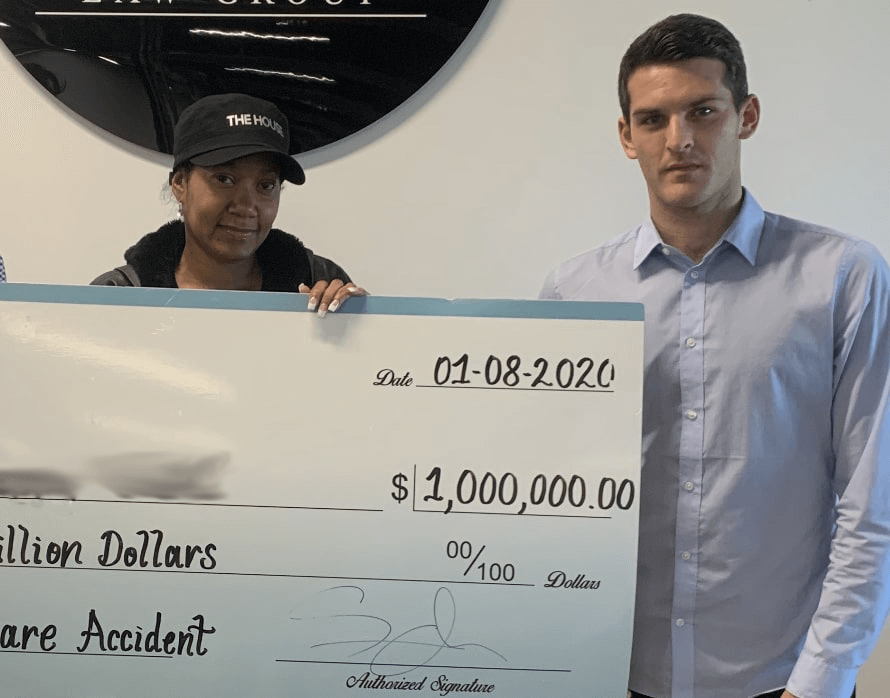
Why is Uber / Lyft Taking Such a Long Time to Pay for my Property Damage?
Unlike medical injuries, property damage claims are fairly straightforward. This is strictly for damages to your car, which are calculated by a licensed mechanic. It’s hard for insurance companies to dispute cold, hard facts and they generally don’t. So if you’ve been waiting month after month for your check, or just to hear back from Uber or Lyft’s insurers, it may be time to call a lawyer. This is the point where many clients have come to us, asking in frustration, “Why is Uber /Lyft’s insurance taking such a long time to pay for the damage to my car?”
We always try to give insurers the benefit of the doubt, as they are working through thousands of claims at a time. In all honesty, it could be 3 to 6 weeks before you hear back from them after you file a claim. This time period can be longer if you have a complex accident with extensive damages. The insurance companies have a right to thoroughly investigate such claims, but they should make that clear to you, as well as the reasons for the investigation. Getting these answers can be difficult for the average person, which is one of the reasons they turn to a lawyer.
In the worst case scenario, Uber or Lyft’s insurers could be intentionally stalling in an effort to scare you into accepting a lower settlement. Or, they may initially reject the claim, and get back to the victim weeks later with an offer they’ll probably accept because they’re happy to get anything at all by that point. This happens much more with medical injuries than property damage, but it’s still a possibility. But figuring out what’s really going on with a claim can be a frustrating experience for many claimants.
Can I Hire a Lawyer to Help me Pay for my Property Damage?
Yes, you can hire a lawyer if you are struggling to recover property damages from Uber or Lyft’s insurance company. It’s sad that victims have to do this at all, since there is very little to argue over when it comes to straight damages to a car. But there are enough claimants out there waiting month after month, or stressing themselves out over endless calls that go nowhere.
The DTLA Law Group finds this unacceptable as insurance companies have a legal duty to address your inquiries and resolve your claim in a timely manner. We can help you if you are in this situation by taking immediate, aggressive action on your claim. Just the fact that a lawyer is involved may get the insurer to take your case more seriously and finally release your funds. Or, we can find out what is still needed to process your claim and get that over to the adjuster as quickly as possible. No matter what action is needed, you can count on us to take care of it and get you the funds you’ve been waiting on.
Our lawyers can also help if the company wants to settle your claim for less what you asked for. Settlement negotiations are not common with property damage claims, but it’s possible for complex accidents. Insurance companies are counting on you accepting the first offer so they can close the case for as little as possible. We will review any offers that are made by the insurer and help you negotiate a fair amount. Or, if your claim is denied, we will take the necessary legal actions to ensure that you are not cheated out of the compensation you deserve.
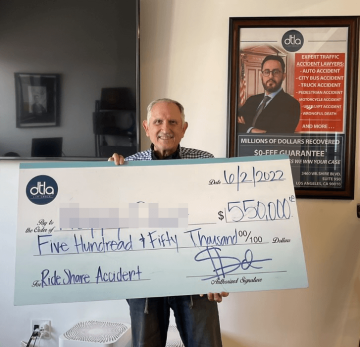
How Uber Is Liable In Accidents
Common Questions
- Can I sue Uber if I was not injured in an accident? You cannot file a personal injury lawsuit if you were not injured in the Uber accident.
Uber can be held liable for injuries and accidents in a few ways. The company has a process that must be adhered to and if they breach the duty of care they owe to their customers, they can be legally responsible for the ensuing damages. Uber must take care when hiring drivers. There is no interview process; the entire hiring process is done through the smartphone app with the prospective driver uploading and submitting all the relevant documents and information. Uber will run the documents through systems and order a background check on the driver. However, the background check only dates back 7 years; anything done before that point will not show up. As a result, many drivers are allowed to drive despite having old records of reckless or careless driving, felonies, drunk driving incidents, history of assault and violence, and more. By allowing these individuals to get behind the wheel and be placed in situations with potentially defenseless customers, Uber can be held responsible for their actions. When an Uber driver gets into an accident or causes a crash, assaults a passenger or places someone in danger, or otherwise behaves in a way that is unsatisfactory and can cause injuries, he will be removed from the app and barred from driving. However, Uber has been known to reinstate drivers or else not ban them at all despite claiming that they would do so. This is troublesome, as it allows drivers the ability to continue with their actions and go unpunished. They can place additional people in danger by being allowed to remain on the app. Uber has been known to do this in the past because of its lack of drivers and desire to secure more income. The more drivers it has on the road, the more fares can be picked up, and thus, the more profit that can be earned.
Other Parties Could Be Liable
If you suffered injuries in a rideshare accident due to defective airbags, then the auto manufacturer could be liable as auto manufacturers have a duty to ensure that their products are completely safe to be on the road. In addition to the auto manufacturers, any car rental companies that made the car available to the driver could also be liable – Uber drivers have the option to book rental vehicles that they could use to complete rideshares. Unfortunately, these rental vehicles can have a number of problems that could be dangerous to drivers and their passengers alike. If the passenger rear airbags failed to deploy on the car that you were renting to drive for Uber, then the rental company could definitely be liable for failing to ensure that their rental vehicles were safe.
Some common questions:
- Can I sue the car company if the airbags failed to deploy on the car I was renting to work for Uber or Lyft?
- Can I sue the car company for defective airbags?
- Do I have a case against the rental company that rented me the car?
- Do I have a case against Uber?
You could definitely sue the rental car company for renting you an unsafe vehicle. Some of the rental companies that are known to work with Uber include the following: Hertz, Fair, GetAround, HyreCar, and Maven Gig, for instance.
Based on the details surrounding the incident, you could also have a case against Uber – especially if they were previously aware of issues with the vehicles provided by the rental company.
For more information about your right to sue Uber or the rental company that rented you the car, do not hesitate to contact the experts at our firm immediately.
How To File A Lawsuit Against Uber
Common Questions
- Do I need an attorney to sue Uber? It is highly recommended that you hire an attorney if you wish to sue Uber, as many people do not have the necessary legal acumen or negotiating knowledge required to win a case.
Armed with the knowledge of what you should do after an Uber accident and how to acquire all your necessary evidence, you should be aware of how to file a lawsuit against Uber. As stated above, there must be a certain duty of care present as well as a breach if you wish to file a claim based on negligence. All personal injury lawsuits are based on such negligent action of the responsible party. The points of negligence that must be proven are as follows:
- You were owed a duty of care by the responsible party
- The duty of care was breached in some manner
- The breach of duty led to an accident or incident
- The accident or incident resulted in actual physical injuries
It is important to understand each point comprehensively. All drivers on the road owe everyone else a duty of care to not harm them or place them in danger. This is doubly true for Uber drivers – they must not place other drivers or pedestrians in danger, but they must also protect their passengers and customers explicitly. The duty of care can be breached by breaking the law or violating road rules. This action can place any number of people in danger, even those who are not on the road. The breach of duty must have directly caused an accident. If the breach occurred but it did not contribute to a crash, the driver won’t be held responsible, or will not be held responsible to the same extent that another party would be. Lastly, the presence of physical injuries from the accident is extremely important if you wish to file a personal injury claim. If you weren’t hurt in such a manner, you will not be able to file a claim seeking compensation for medical expenses or other damages. Instead, you will only be able to pursue damages for the loss of property and loss of wages you suffered. Fortunately, if you plan on pursuing an insurance claim against Uber, you may have more success if you were not injured. You also may not need an attorney to litigate the case for you. The reason is simple: a mechanic’s estimate and a copy of your pay stub may be enough to display your losses, and you could simply negotiate a fair deal from the insurance agent yourself. Agents will be more responsive to claims that do not lead to them giving up large sums of money, and they would rather focus their efforts on other claims that are rife with injuries and could result in huge payouts.
Common Questions
- Why are some settlements public and others private? There are generally clauses in lawsuits and verdicts that dictate whether or not a party can disclose the settlement amount. This is often done to protect both parties.
From the time that Uber vehicles rolled out onto the streets a decde ago, there have been lawsuits creeping on the company’s tail. The most well known case involved the Liu family, which saw a six-year-old girl die at the negligent driving of Syed Muzaffar. Other cases involve Uber’s employees and drivers taking action against the company. In July 2016, Uber settled a number of lawsuits. Some include:
Gratuity/ Tip Case
Uber was forced to pay 47,000 drivers nearly $385,000 in tips that the company had wrongfully taken from their pockets. Initially, the tips were thought to be a forced gratuity in the vein of taxi services, but it was soon discovered that the money was not going to the drivers. The forced 20% gratuity was later removed and an optional tip service was implemented.
Background Checks
Uber terminated dozens of drivers for not having records that were up to the standards of the company. However, Uber illegally acquire the background checks without the permission of the drivers. The company owed over $7,500,000 to the affected individuals who lost their positions. In addition, Uber is said to have misguided or misled prospective drivers and to have missed important information by not using fingerprint methods for background checks. As a result, the company missed 25 drivers who had criminal records and would not be allowed to drive, as per Uber’s standards and regulations. The choice to lobby against fingerprint methods and the ensuing risk cost Uber $25,000,000 to be paid to the District Attorneys of Los Angeles and San Francisco.
Discrimination Lawsuit
Uber’s employees who worked in Information Technology and Programming filed a claim stating that Uberr practiced discrimination in the workplace and had problematic wage distribution. 56 employees joined together in a class-action lawsuit claiming sexual harassment in the workplace, for which each individual would won roughly $30,000 in a nearly $2 million dollar case. In addition, over 400 others joined the lawsuit that showed that there were pay disparities at the company. Women and people of color received a collective $5 million in the class action claim.
Embellishment Claim
Throughout 2015 and 2016, Uber claimed that its drivers in New York and San Francisco made median yearly incomes of $90,000 and $74,000, respectively. However, it was later discovered by the Federal Trade Commission that the earnings were drastically lower – $61,000 for New York drivers and $53,000 for San Francisco drivers. Few drivers earned the numbers that Uber initially stressed. In addition to the misrepresentation of earnings, Uber also wrongly advertised the details of its vehicle leasing program. Drivers were slated to pay much more than they had previously thought due to additional fees and charges that Uber did not list. As a result of the embellishment, the FTC won a $20,000,000 settlement from Uber, the criteria of which included Uber to stop advertising false or unsubstantiated claims or representations about driver income and vehicle leasing programs.
Sexual Assault Lawsuit
Two different women filed a claim against Uber alleging that their drivers sexually assaulted them. The incidents took place in Boston, Massachusetts, and Charleston, South Carolina. The history of sexual assaults by Uber drivers played a part in Uber quietly settling the claim with the women, although the amount was not disclosed. In fact, many settlements from Uber cases are not made public. One of the stipulations of the agreement is that the insurance company and the plaintiff do not make t known how much the settlements were for, as it could lead to a lot more public scrutiny – scrutiny that Uber likely does not want and would not benefit from.
Undisclosed Settlements from Accidents
2015: A young individual in Miami called an Uber to bring his party home, but was killed when the driver turned into oncoming traffic and flipped over. The vehicle was set ablaze and killed the 20 year old. The crux of the case centered n the fact that many drivers elect to drive late night shifts despite working all day or not getting adequate sleep, thus resulting in higher risks of accidents. The other people in the party claimed that the driver was indeed not looking at the road when he turned. 2015: Also in Miami, a couple was involved in an accident with an Uber driver who did not follow the correct right of way and turned across a lane of traffic. The couple suffered umerous injuries, but the wife was left with brain damage that required surgery to fix and permanently altered her ability to continue working as a nurse. The Uber driver did not get all the proper licensing and did not fit the necessary qualifications for the position. 2015: An Uber driver in a minivan picked up a young woman and her group after the group had been at a few clubs throughout the night. The minivan driver ran a red light and was T-boned by a truck that was passing through the intersection. The crash left the young woman paralyzed from the neck down. A lawsuit filed against the company stated that the driver was not properly insured and had a history of arrests for reckless driving, thus showing Uber’s negligence in its hiring practices. 2017: An individual was present in an Uber that was on the highway. The passenger was legally in the car and due to the nature of fast lane and carpool lane laws, the Uber driver was allowed to travel off to the left. However, while driving, he did not notice that a vehicle had stopped and was not moving in the car pool lane. The Uber driver struck the vehicle and the crash severely injured the passenger. The car that was stopped had come to a stationary position because it had just been involved in an accident, and it was now struck again. The victim in the crash sued the driver and Uber for negligence; he suffered severe pain and injuries to his back and neck, including the need for surgery on his spine. 2017: A woman was driving for Uber and on her way to pick up a passenger. While driving on the freeway, she was rear ended by a negligent driver. The driver in question did not have adequate enough insurance to cover the damages; the insurance company’s limits only covered a small portion of the incident’s expenses. As a result, James River Insurance and Uber were held responsible for the remaining 95% of the debts.
Statute of Limitations for Filing a Lawsuit against Uber
Common Questions
- Can my statute of limitations be extended? Yes, depending on the circumstances of your case.
- If there is new evidence or injuries, can I file a claim against Uber? If you have not previously filed a claim, you can still pursue damages for your injuries, provided you are within the time limit.
- What statute of limitations applies to child injuries?
In the event that you wish to file a lawsuit against Uber for damages suffered in an accident, you should be aware of the statute of limitations for the claim. You do not have an infinite amount of time to sue Uber. As it stands, you will likely be filing a personal injury lawsuit if you were injured while in an Uber vehicle or while using one of Uber’s other modes of transportation, or if you were struck by an Uber driver or rider. The statute of limitations exists so that claims do not take too long to get settled and are handled in an efficient and speedy manner. Further, it protects both parties from unfair practices. For example, if an accident happens and the passenger suffers a sprained ankle and a sprained wrist, he may be out of work for a few weeks and he may need to get checked out by a doctor. These costs may not be too high and he may cover them in the moment to ensure that he gets treatment. He may suffer a small setback on paying his bills but nothing serious. If he then elects to sue the driver five years later during a new financial crisis, it would be extremely unfair to the driver, as he has not been previously contacted and the injuries have already healed, while the expenses were already paid with no great loss to the plaintiff. The deadline to file a personal injury lawsuit for an Uber accident (or any car accident resulting in physical harm) is 2 years from the date of the injury. This is sometimes difficult to pinpoint, as the injury may not have occurred on the same day as the accident. For example, if you were in an Uber crash but two weeks later you started to notice severe back pain, the de statute would begin from the time the back injury started as opposed to when the accident occurred. If there were no injuries, then you would likely be filing merely a property damage claim. This claim has an additional year tacked on to it, so you would have 3 years from the date of the damage done to the items to sue for compensation. There are ways in which the statute of limitations can be extended beyond the two-year liit, though. This is called a tolling of the statute, and it allows special circumstances to dictate the length of time that victims have to file lawsuits. For one, only individuals over the age of 18 can legally file lawsuits against negligent parties. This means that any minors do not have the ability, and thus, do not have to adhere to the two-year statute. The statute of limitations will only kick in for the minor once he turns 18 years old. This means that injuries suffered at 13 years old can still be used as a basis for a lawsuit five years later. An Uber accident can very well leave a victim in a critical condition, whether physically or mentally. There is the possibility that a victim can fall into a coma, suffer brain damage, or else have a high level of stress and suffer a nervous breakdown. These individuals do not have to adhere to the statute of limitations while they are incapacitated. Instead, they would only be held to the deadline when they return to functioning health and can reasonably file a claim. It is required that the defendant be present in the state if the plaintiff is suing for damages. At times, the defendant may flee the state for a few weeks or months and live elsewhere, or he may permanently relocate. The statute of limitations, therefore, would be suspended throughout his absence and would resume when he returns to the state. A defendant may leave to try and avoid a lawsuit. There are other, less probably or uncommon ways that the statute of limitations can be extended. These include the defendant being sent to prison, the country entering a time of war or the defendant or plaintiff enlisting in military service and being deployed, the defendant being rendered or pleading insane, and more. Failure to file a lawsuit within the two-year limit on the statute of limitations or within the extended time period will prevent any compensation from being handed out. A victim will not be able to pursue a claim and will not have the chance to have his damages recouped. In order to guarantee that you have the right time frame and that you know when all the important dates were – the date of the Uber ride, your doctor’s visits, a confirmation of a diagnosis or injury, and more – you should write everything down and keep meticulous records. The more details you have, the better prepared you will be when you take legal action.
The Statute of Limitations for Minors
Minor passengers traveling with other adult passengers in rideshare vehicles as well as minor passengers in other vehicles or minor pedestrians can be injured in rideshare accidents. Although the parents of injured minors can sue for the harm that their children suffer in rideshare accidents, injured minors also have the option to sue once they are of age. That is, the applicable statute of limitations is tolled until the injured minor turns 18. At 18-years-old, the two-year statute of limitations starts. Therefore, a minor injured in an Uber accident could sue up until he or she is 20-years-old. This is because injured minors have two years from the date of their 18th birthday to file a lawsuit in California State Court against a private individual or company, like Uber. For more information about the specific statute of limitations that applies to your Uber accident claim, do not hesitate to contact our experts immediately.
Determining the Value of Your Uber Lawsuit
Common Questions
- Why is there no set amount for the value of a claim? Each claim is different, and it would be wildly unfair to victims if everyone received the same amount of compensation for injuries that could affect one person more severely than another.
Why is the value of my case determined by an insurance agent? Each case is different, and not every injury is the same. There should always be different results based on the circumstances of the accident. Many individuals who wish to file lawsuits against Uber do not understand how the claim process works or what they may potentially earn from a lawsuit. It is important to understand that an insurance claim is not simple; you will likely have to fight an insurance agent for weeks or months to get any headway, and in many cases, agents simply ignore people until they get frustrated and drop the claims. Generally, attorneys can be used to facilitate the claim process. When you file a lawsuit, you will be seeking compensation for damages from the Uber accident. A representative from James River Insurance will receive your claim; it may take up to two weeks for him to consider it. He will then look at these factors to determine the worth of your claim:
- Your age: If you are younger and have fewer financial responsibilities, you may receive a smaller offer than if you were older and had various bills to pay.
- Your job: Your job may be able to be completed remotely or with reasonable accommodations from your employer; if this is the case, you do not have to worry about losing too many wages. However, if your job is nuanced or unique, you may be in for more compensation. Being unable to return to work or having to go on permanent disability would result in a larger sum.
- Your injuries: The severity of your injuries will greatly impact the value of your claim. The amount of damage you suffered will be an important point to consider, as well as how extensive and long lasting they were. If your injuries were simple and did not require surgery, such as a sprained ankle, cuts and bruises, or a concussion, you would earn less than if you suffered a severed limb, were rendered paralyzed, or had an internal organ removed.
- Your level of negligence in the accident: If you were a fellow driver n the Uber accident, the insurance agent will look at your statements and weigh them against the other evidence. If you contributed to the accident in some way, the agent can reduce the offer he makes you or the court can find you a certain percent negligent and deduct from there. For example, if you were driving with your lights off at dusk when you were hit by an Uber driver, you could be held partially accountable. The driver may have run a red light but did not see you because of your lack of lighting. Had he seen the headlights, he may have been able to stop, but he was still driving too fast and was going to run the light regardless.
Once the insurance agent has come up with an offer, a lawyer will work to negotiate a fairer deal. The insurance agent for Uber has one goal in mind: to protect profits and to not pay out claims. If insurance companies paid out every claim, they would lose a ton of money; therefore, they take their team and deliberately lowball and make paltry offers. With the assistance of an attorney, your case could double or triple in value. Your attorney will strive to win these damages for you:
Coverage Of Medical Expenses
Your medical bills stemming from the accident may be extensive, especially if you were severely hurt. An ambulance ride is not cheap, for one, and the emergency services can be covered. You could have been hospitalized for some days or weeks and required various surgeries to repair damages. You may need medication to counteract the pain and to deal with certain problems moving forward. There may also be various physical therapy sessions that you need to attend in order to regain control and range of motion of certain body parts. These sessions could be paid per visit. There is also the chance that you will need to return to the doctor for further medical treatments. Some damages require numerous surgeries over a period of time, and if damages continue to linger, the coverage can extend past the initial period. You may also need secondary medical procedures and items. For example, you may need to walk with a cane or be confined to a wheelchair, both of which may be costly. These fees can be tacked onto your lawsuit.
Property Damage
Your vehicle could have suffered intense or irreparable damage if you were driving a car that was hit by an Uber driver. The mechanic could provide an estimate to repairs, but the costs may not be worth it, and it may be in your best interest to simply purchase a new vehicle. In addition to the costs to repair your vehicle, the numerous personal items and belongings you had that were damaged or lost in the Uber accident can be covered or reimbursed. Your phone may have been broken, lost, or shattered, and your laptop, textbook, other electronics, and jewelry could have been damaged beyond repair. Further, in tandem with medical expenses, you may need certain accommodations after the accident. Your home could be refitted to accommodate a wheelchair, including making hallways wider and installing ramps. You may even need to buy a vehicle that is handi-capable. Paralyzed individuals, as noted above, may receive ample compensation for these additional damages.
Missed Income from Your Job
You very likely will miss some days of work after getting in an Uber accident, but the amount of time you miss may be highly dependent on your injuries. If you were unable to go to work because your car was totaled, your day’s wages could be reimbursed. However, a longer period of absence or leave due to damages or recovery time could be given to you by Uber’s insurance company. You may not be able to work remotely or complete any job duties while injured. You may not even be able to go to work until you are fully healed because your job requires you to be functional and you cannot receive accommodations that would help you. If you had to go back to the doctor for additional medical procedures and needed to leave work, or if you had to recover from these additional procedures, your future wages could be paid to you as well.
Pain and Suffering
Pain and suffering damages are non-economic in nature, meaning they do not cover losses that can be numerically expressed. Instead, they cover the emotional traumas suffered during and after an Uber accident. It is not uncommon for victims to be mentally anguished afterward and must suffer through internal psychological damages in addition to physical pain. The lawsuit process and negotiation process can also decrease your mental health and cause you to have your stress levels skyrocket through the roof. High stress levels can delay recovery times, making you even more injured than before. These damages may cover fear of going out or using an Uber or rideshare vehicle again, anxiety that comes with getting in a vehicle with strangers or sitting in a taxi cab, post-traumatic stress disorder (PTSD) that causes triggering episodes of terror or paralysis after a particularly damaging or impactful incident, and more.
Punitive Damages
Punitive damages are additional forms of monetary compensation that are handed out if an Uber driver or party has acted with gross negligence or if he intentionally tried to harm you. These damages are meant to punish the individual and dissuade him from acting in a similar manner in the future. They are handed out in civil lawsuits only and are meant to take the place of jail time. They are not easy to win, though. Many judges, juries, and agents view these damages as excessive, harsh, or unnecessary, and feel that the defendant should be made to pay for what was damaged and that’s it. It will take a skilled lawyer to be able to win these damages for your lawsuit.
Wrongful Death Expenses
In the most tragic of cases, friends or family members may die in Uber accidents or pass away due to injuries stemming from the crash. These individuals may be alive for some times afterward but ultimately not pull through. Surviving family, significant others, spouses, or other parties (in very restrictive cases) can file a claim against Uber. The damages can cover the costs and expenses of the funeral, burial, wake, and other services. There will also be coverage available to take care of any medical bills and pain and suffering that were in place before the death happened. The victims may have had an inheritance saved up for their children or they may have been the primary caretaker in the family; the income and funds can be paid in a lawsuit. Further, any loss of relations or consortium or sexuality can be paid off to the surviving spouse.
Can I Settle a Case against Uber for Injuries on My Own?
Claimants could technically handle any sort of injury claim independently; however, doing so is not recommended. Although it is possible for you to handle your case without expert representation and even successfully settle your case against Uber, it is very unlikely that you will be able to recover a fair payout for the harm that you suffered. This is because Uber does not want to pay. Without a lawyer handling your claim and ensuring that your claim is taken seriously, Uber will be quick to take advantage of your situation and do everything possible to avoid paying you what you deserve.
¿Puedo resolver mi caso en contra de Uber por mis lesiones yo mismo?
Aunque es posible manejar su caso y hasta llegar a recuperar una recompensa sin involucrar a un abogado, no es recomendable. Si es posible, pero es muy rara la vez que un caso en contra de Uber se pueda ganar sin la ayuda de un abogado. Sin un abogado, usted y su caso están en gran riesgo – Uber hará todo lo posible para aventajarse y no pagarle lo que se le debe.
Do I Need to Hire a Lawyer to Handle My Injury Case Against Uber/Lyft?
Yes, you need to hire a lawyer to handle your rideshare injury case against Uber or Lyft. Just because you could technically try to handle your claim without a lawyer doesn’t mean that you should. Hiring a lawyer to help you with your injury case against Uber or Lyft will be the best decision that you could make for your injury claim. Your lawyer will deal with the rideshare company to ensure that your claim is prioritized, that your rights are protected, and that you are rightfully compensated. Without a doubt, there are benefits of hiring a lawyer to represent you – trying to handle your case independently is just an unnecessary risk.
¿Necesito contratar un abogado para manejar mi caso contra Uber o Lyft?
Si, usted necesita contratar a un abogado para que le ayude con su caso de Uber/Lyft. Solo porque técnicamente puede intentar manejar su caso individualmente, no quiere decir que lo deba hacer. Con la ayuda de un abogado experto en accidentes de Uber o Lyft, sus derechos serán protegidos de principio a fin y su abogada peleara por su derecho a recuperar la mejor recompensa posible. El tratar de manejar su caso sin la ayuda de un abogado es simplemente un riesgo.
Hiring an Attorney for Your Uber Accident
If you wish to hire an attorney for your Uber accident lawsuit, you should select a lawyer who has experience handling Uber accident claims and other rideshare lawsuits. It is important that your attorney know what he is doing and can negotiate with an insurance agency that he is familiar with and has past cases with. Some attorneys merely handle car accident claims and are in unfamiliar territory when they delve into Uber lawsuits. It is also recommended that you seek out an attorney who will connect with you and be up front about the realities of your case. Some attorneys will take on numerous cases at a time and try to rush through them in an attempt to settle quickly and get his cut of the payment. He will then move on to the next case, and rinse and repeat. This will allow the insurance companies to be more likely to work with him in the future and will cost him less work and energy, all while damaging the client’s life.
At our law firm, the Downtown LA Law Group, you will have access to the best attorneys in town and will always be able to ask us for updates and answers to your questions. We offer all of our clients free legal consultations about their cases. During these consultations, none of your private details will be shared with anyone else, and your case information will be kept totally confidential. You will not have to worry about any sensitive points getting released anywhere; everything we discuss is talked about in confidence. We invite you to ask us anything you wish during the consultation, and we will gladly tell you what we believe your case is worth and how much we think we can win for you. You can reach us around the clock – 24 hours a day, 7 days a week, 365 days a year. We are always available.
In addition to our free consultations, we make sure that our clients are properly treated and are not in danger of losing any funds. We offer a zero fee guarantee to all clients, which promises that you will not spend a single dime of your own money throughout the lawsuit against Uber. We will cover all the costs of the case from start to finish, including filing important documents, hiring expert witnesses, and more. You should focus on recovering and returning to your normal life while we handle the legwork of the case. We will not get paid or take any money unless we win your lawsuit. The fees will then be taken from the settlement we bring you, so you do not pay any of your own money at all. Uber and the insurance agency will cover the legal costs. If we do not win your case, we will not ask you for reimbursement. We will eat the losses ourselves and you will be debt-free to our firm.
You may already have legal representation, but you may not trust the direction your lawyer is taking your case or you may feel that your claim is worth more than is being offered. You can always receive a free second opinion from our firm if necessary. You should not be privy to poor representation, and we will tell you if we think your current lawyer is doing a good job or if he is not giving you his best efforts. We will also help you understand if you are a victim of bad faith, whether by the law firm you are with or by the insurance company you have a claim with.
Can I Switch My Lawyer in the Middle of an Uber or Lyft Accident?
If you are unsatisfied with the way that your current attorney is handling your case, then you might be interested in switching attorneys and getting better representation. Can you switch lawyers in the middle of your case? Yes – you can switch your lawyer in the middle of your case. Regardless of the cause behind your decision to switch, you can switch lawyers relatively quickly. In most cases, all you need to do is notify your previous attorney that you will be switching representation; the court will also need to be notified (although your new attorney should handle this).
Will you have to pay anything to switch representation? No, you will not have to pay any upfront costs to switch lawyers. Of course, your previous attorney will need to be paid for the time that he or she worked on your case; however, this payment will typically come from your final settlement. You should never expect to pay anything out of pocket.
For more information about switching your lawyer in the middle of your Uber or Lyft case, do not hesitate to seek legal assistance with the experts at our firm today.
Can I Fire My Lawyer After a Failed Mediation in Uber of Lyft Case?
Yes, you can fire your lawyer after a failed mediation or at any point during your case. Some people disagree with this approach since you are far along in your lawsuit by the time you reach mediation However, this is a crucial point in your case, and it’s essential that you have faith in your attorney’s abilities. Once mediation fails, you will have to request a trial date and prepare to argue your case in front a judge and jury. This is where a lawyer’s skill really counts, so you must retain counsel that you really believe in.
On the other hand, a failed mediation isn’t always the attorney’s fault. That’s why we invite you to come in for a second opinion, so that we can review the circumstances between you and your current lawyer. Sometimes your differences are a matter of personality issues, but your lawyer is doing everything they can to bring you a fair settlement. In that case, it may be better to have an honest discussion with your lawyer and see if you can work out your differences. But we have definitely seen cases where the attorney lacked the knowledge and experience needed for a particular client’s accident. There is no point in sticking with an inexperienced lawyer, since they are unlikely to bring you a successful outcome in a trial.
The important thing is to speak with another attorney right away. Changing lawyers is absolutely possible, but it’s a big decision that requires careful thought and consideration. If you’re unhappy with your lawyer after a failed mediation, please come in and see us for a free second opinion. If it’s in your best interest to switch to us, we will notify your attorney and the courts, and work out an agreement to compensate your attorney for their work.
At the end of the day, you need a lawyer on your side that inspires confidence and makes you feel like a priority. The attorneys of DTLA Law Group will do everything we can to assist you during this challenging time in your life.
The Ultimate Guide to Uber Accidents
– Lawyers for Second Opinion on Your Uber Accident Case
– Ultimate guide to Uber Fair and Mave
– Lawyers for Second Opinion for Your Lyft Accident Case
– Uber Driver Injury Protection Plan
– What to do After a Lyft Accident?
– Uber/Lyft Accident: Steps to Take as a Passenger
– Uber Lyft sexual assault attorney
– Uber Insurance – Top things you must know Uber Deductions
– UBER deactivated my account after an accident
– UBER sudden stop accidents
WE FIGHT
YOU WIN!
Se Habla Español


